#and then using substance painter to practice the art aspect
Explore tagged Tumblr posts
Text
Introduction
Hi Hello I have been playing scotl for about a year and a half. I remember my first ever interaction with scotl was Piccrew, and I was like I love this. The first season I existed in was season of remembrance, and my first season I participated in was I believe season of moments.
I take photos and create(bad) music.
I have a plan of learning to 3d model with creating the sky kid mask and other items.
#sky children of the light#introductory post#blender modeling in the future#and then using substance painter to practice the art aspect#sky screenshots
1 note
·
View note
Text
Defining the Forefront 4
youtube
At the beginning of my production period, I contacted Lara D'Adda to try and see if I'd be able to interview her or have a small zoom call for tips and tricks from her experience in creating stylised 3D assets. Unfortunately, her busy schedule did not allow her to have any mentoring or one-on-one meetings. Nonetheless, she kindly directed me to a recent video of her where she breaks down her process, which was extremely helpful for me. Her recent insights into creating stylized assets and materials offered me a multitude of techniques that I found resonant with my own workflow.
One of Lara's standout techniques is her emphasis on color variation. She points out that even in stylized art, surfaces rarely possess a single, flat color. Instead, they are characterized by subtle variations and gradients that add depth and interest. In her workshop, she demonstrated how to use tools in Substance Painter and Substance Designer to introduce these variations effectively.
Reflecting on this, I've begun to apply Lara’s color variation techniques to my own assets that went into the solarpunk environment. Incorporating gradients and varied color layers in my materials helps to break up monotony and infuse life into the scene. For instance, applying gradient maps and tweaking color variations in Unreal Engine 5 has allowed me to create surfaces that feel both dynamic and cohesive, which also blend in well with the environment. The position gradient maps which I've created based on D'Adda's methods were used for purposes other than colour variation, such as making moss or dirt at the bottom of objects where they touch the ground.
Lara’s discussion on painterly effects and highlights was the most helpful of all. She uses techniques such as blur slope in Substance Painter to achieve a smudgy, brush-stroked appearance that lends a hand-drawn quality to her assets. This technique is not just about aesthetics; it also helps in creating a consistent visual language throughout the project, which differentiates it from other art styles.
In my own work, I’ve applied these painterly effects to align with the stylized nature of my solarpunk environment. By applying similar techniques in Substance Painter, using both grunge maps and alpha textures, I’ve been able to maintain a consistent, artistic style across different elements of the scene. For example, creating brush strokes and 2D imperfections adds an allusion to a painted anime style.
Lara’s approach to modularity and efficient texturing is another crucial aspect I found valuable since I struggle with it a bit when handling big projects such as this one. She emphasises planning and breaking down a project into manageable parts, focusing on reusing textures and materials where possible, which is something that I have been doing ever since. This method not only makes the workflow more efficient but also ensures consistency in the final look or feel or the environment. Lara’s advice on planning textures and materials ahead of time has guided me in setting up a more practical workflow and achieving the same asset quality throughout the environment.
Finally, I came to realise Lara’s way of using reference materials and the thorough pre-production planning: getting both examples and for style and detail produce well-informed judgments and a clearer vision of the end result. It is this aspect of preparation that has been essential in making sure that the stylised elements of my solarpunk environment are not only aesthetically pleasing but also show consistency in the general feelings or mood that the project is supposed to portray.
Source:
Beyond Extent. (2024). Intro to Stylized Materials with Lara D'Adda. YouTube. [online video] Available at: https://youtu.be/KEKrenjkYMA
0 notes
Text
2. Forefront Research -God of War Process
Another game series that has strongly influenced my art choices is God of War. While doing my research on the forefront games that I believe to have raised the bar when it comes to games art, I came across an article posted by Richard Leadbetter on Eurogamer, which analises in detail the 3D modeling of God of War 3.
Fig.1: The Making of God of War III Article by Richard Leadbetter
The original God of War 3 was released in 2010, it has been remastered in 2015 to match the level of current games platforms such as PS4 and PS5. Even though it may be considered old, the article still provides essential information regarding the studio production of the characters, which helps me get a deep insight of their work pipeline, as well as understand the technical evolution of the industry. Not to mention, at it's time of release, it was considered the world's number one videogame.
In the article, art director Ken Feldman states that "Kratos went from being a couple of megabytes to now, it would actually take two PS2s to fit his memory footprint all in there. He is always loaded in the game. The other thing is that he has many more weapons, too. He can load between all of those different weapons, so all that stuff is loaded with him also, and all the move sets", which underlines the dramatic evolution of the memory capacity artists now have in order to make the characters.

Fig.2: Character Sculpting Process
What I found very interesting is that both God of War 3 and the Diablo 4 cinematic I previously talked about, were animated manually, because "it was found that the animators themselves produced more effective work than basic motion capture from the actors offered". The technique they used to create the realistic muscle movement is called "blended normal mapping", which back then was something new, and now it became a standard practice.
For my future projects, I intend to dive dipper into the normal blending technique to create facial expressions for my characters.

Fig.3: Animation Simulations
Another interesting technique they created for the game is the dynamic simulation, used for animating parts of the characters such as hair, cloth or other organic parts such as gorgon's snakes, as Gary Cavanaugh states: "each of the snakes on the gorgon's head is independently moving. The animator did not have to individually pose all of these animations, but they do have control over the physics… it improves a lot of the workflow for animators".
Adding organic and simulated elements to the characters brings a lot of realism and makes the characters look more alive. So far, I stayed away from the complex simulations, and only with my major project I have started working with cloth simulation, which was a major step up for my characters.
In addition to the article, I have found a YouTube video by Game Lock, which shows behind the scenes of God of War 3 character art.
youtube
Fig.4: God of War 3 Character Art by Game Lock
In the video, they present their workflow from concept art, to 3D sculpting the models in ZBrush and the level of detail they were able to add in the game, once the technical hardware advanced. Moreover, their workflow shows pipeline elements such as using Photoshop to paint the textures over the UV maps. This technique is essential for understanding UV mapping and having clean topology, which my teachers also advised us to learn. Even though nowadays we use software like Substance Painter which can create procedural textures, knowing base techniques helps the 3D artist tremendously.
Following my research, I have also found an article which analyses the visual aspect of God of war Ragnarök, which is the latest game from the series, released in 2022.
Fig.5: God of War Ragnarök Visual Analysis Article by Rashid Sayed
In his article, Rashid Sayed says "God of War Ragnarök is an absolute beast when it comes to graphics", which is a statement considered by many other artists. In the section where he analyses the character models and animations, he mentions that the crucial thing that helped with the improvement of the quality of the models is the increased poly count of the base mesh. Seeing that nowadays the threshold of poly count for characters in games has increased dramatically from where it was when I first started sculpting, brings me comfort. Previously trying to achieve high-end realistic results, while having to keep the base model under 20 000 polygons, was really hard. As also mentioned in the previous article, rasing the bar of hair, cloth and physics simulations for the characters, was the key factor of their success in creating such high-end graphics for a game.
In addition to the articles, I have found a YouTube video by Gnomon, which showcases the process of rigging and animating the characters of God of War Ragnarök.
youtube
Fig.6: Rigging and Animating Process of God of War Ragnarök
I found it extremely useful to see their goals and mindset when creating the animations and the planning they did for the project. After watching this video, I understood many things about planning and managing the pipeline and what to keep in mind when working on the project. I implemented many of their goals in my own project, which helped me get my project closer to industry level.
Bibliography:
Fig.1,2,3: Leadbetter, R. (2010) The making of god of war III, Eurogamer.net. Available at: https://www.eurogamer.net/the-making-of-god-of-war-iii
Fig.4: Game Lock (2017) God of War 3 Behind the scenes character art. YouTube. Available at: https://www.youtube.com/watch?v=K7pUkpnAVwY
Fig.5: Sayed, R. (2022) God of war Ragnarok tech analysis – A visual spectacle on PS5?, GamingBolt. Available at: https://gamingbolt.com/god-of-war-ragnarok-tech-analysis-a-visual-spectacle-on-ps5
Fig.6: Gnomon (2018) Character rigging & cinematic animation in God of War with Erica pinto & Axel Grossman. YouTube. Available at: https://www.youtube.com/watch?v=kCpdVm2bWEI
0 notes
Text
- Specialist Practice -
My specialist practice for this project is environmental and character design. I really wanted to focus on this specialist as over the past projects I have enjoyed this aspect the most in game design. I would love to focus on lighting, colour and character design as well as the overall environment.

I have also had many opportunities to work on these practices and are quite confident in my ability to produce something of good quality as well as being extremely eager to learn more skills in environmental design as well as character design. In past projects I have drawn concept art to showcase and develop ideas which I would like to do in this project.
I plan to build on strengths from previous projects by focusing on concept art and creating final artworks using either photoshop, maya or substance painter. These are all applications that i am fairly well versed in, however I could definitely improve on.


I also plan to as well as, stick to the stuff I enjoy making and are confident in, I’d also like to branch and try a few things I’ve not tried before in the hopes of making myself much more versatile for the game industry.
For this project I would like to continue doing things I have found to be very productive towards such as concept art and character design, as well as plot development.


I think focusing on these aspects will give me a much better outcome for my final project and will keep my productivity high. However, as well as those things I would also like to focus on my weaker parts of the last projects, things such as narrative writing and gameplay structure. I have always struggled with writing and I believe that it is a much weaker part of my previous projects, to help with dialogue I will try to watch videos guiding people through the process of writing dialogue whilst also looking up game examples and media to take inspiration from.
To help improve my structure of gameplay I’m going to focus a lot more in the initial stages of planning the game and work out what kind of gameplay I want so I can base the art and area around that.
0 notes
Text
Industry Practice 8
How to Make Tool Kit with History Using ZBrush & Substance 3D Painter
As a game artist, I like creating very realistic and stunning landscapes and objects for people to interact with in games. I recently came over a great post on 80.lv that explains how to make a toolbox appear as like it has been used for a very long period. The post described how the artist assembled the toolbox piece by piece using ZBrush and Substance 3D Painter. I want to make everything in my game environments appear to have a history, thus this post is ideal for me. The article described how the artist gave the toolbox little touches like dents and scratches to give it a worn appearance. They also used images of actual toolboxes to ensure that theirs appeared authentic! The most fascinating aspect was discovering these unique initiatives. With ZBrush, one software, you may sculpt objects in three dimensions, such as creating a clay model. You may apply textures to the 3D model using the other software, Substance 3D Painter, to give the toolbox a rusty or greasy appearance. I want to learn more so I can improve the appearance of my game items, even if I already utilize various tools similar to this one. This piece also reminded me how vital research is in art. Just like the artist looked at photographs of genuine toolboxes, I may look at pictures of real locations and items to make my gaming worlds more realistic. Learning from this post inspires me to better my talents and create more cooler content for my games. I can't wait to test out these new methods and see what type of great things I can make.
Huangyulong. (2023, November 28). How to Make Tool Kit with History Using ZBrush & Substance 3D Painter. https://80.lv/articles/how-to-make-tool-kit-with-history-using-zbrush-substance-3d-painter/
0 notes
Text
Silver Threads of Heritage: Exploring Hopi Jewelry Artistry
In the heart of the American Southwest, culture, history, and artistry is revealed via the intricate threads of Hopi jewelry. Each artwork carries the legacy of a people whose traditions have been passed down through generations.
From the handsome glint of silver to the vibrant hues of stones, this type of jewelry reflects a rich heritage celebrating craftsmanship, symbolism, and a deep connection to the land.
In this article, we will explore this art form by uncovering the stories woven into each artwork and the enduring spirit of the Hopi people.

A Glimpse into Hopi Culture
The Hopi people, who live in the dry regions of northeastern Arizona, have a strong sense of connectedness to and regard for the natural world. Their jewelry is linked with this spiritual connection, since each item references their collective psyche.
Their jewelry, from the most basic earrings to the most ornate necklaces, is a vehicle relating to their cultural heritage.
The Allure of Silver
Silver is the main material in Hopi jewelry craftsmanship. This is because of its glossy luster and malleability. This metal is more than just a substance. It is a blank canvas to paint tales, traditions, and worldviews.
By utilizing techniques handed down through the decades, Hopi artists have mastered working with silver to produce stylized designs honoring their ancestors.
Innovative Designs with Symbolic Significance
Jewelry made by the Hopi people is recognized for its dramatic designs, which frequently incorporate geometric patterns, motifs taken from nature, and culturally significant symbols.
Each aspect of the design has a symbolic meaning, conveying tales of spirituality, creation, and the interdependence of all living things. The water may stand for purity and rebirth, while the spiral may represent the path of life.
Thus, these patterns acknowledge the cosmos as a guiding force, including the sun, moon, and stars.
Techniques Spanning Time
The methods used to create Hopi jewelry prove their artists' skills. An overlay hallmark method entails thoroughness cutting and soldering two sheets of silver to produce a three-dimensional impression that gives the design depth.
Another conventional technique is called tufa casting, which entails cutting elaborate designs onto tufa stone to produce a mold for pouring molten silver.
These methods have been used by Hopi artists for years now which guarantee that each jewelry is a one-of-a-kind work of art.
From Tradition to Innovation
While having a strong tradition-based foundation, these jewelries value innovation and adaptation. Hopi contemporary painters incorporate contemporary elements into their works while drawing inspiration from their cultural background.
This blending of the old and modern illustrates how culture is dynamic and shows how tradition may change without losing its essential qualities.
Cultural Significance and Rituals
Hopi jewelry is more than just an aesthetic statement. It is ingrained in daily life and ceremonial practices. Ceremonial jewelry has great spiritual importance and is frequently worn during holy occasions.
The Hopi spirit creatures known as katsina are frequently portrayed in jewelry as a bridge between the material and spiritual worlds. Wearing these items expresses identity and a tribute to the ancestors.
Preservation and Revival
Over time, the legacy of Hopi culture & artistry encountered obstacles such as cultural appropriation and commercialization. The Hopi people, however, are adamant about preserving and reviving their customs.
A newfound understanding of the cultural significance of their jewelry has resulted from efforts to teach their community and the larger world about it.
Conclusion
Hopi jewelry artwork is a testament to the resilience of a culture that thrives in harmony with the earth. The Hopi people have preserved their stories, traditions, and spiritual beliefs through generations of hands that have shaped silver and stones.
This jewelry adorns the body and carries with it the soul of a community, inviting us to cherish the beauty of their artistry and the wisdom of their traditions. Savvy Collector brings amazing artwork of Hopi jewelry. Visit our official website to encompass a diverse spectrum of artworks, seamlessly blending tradition and modernity.
0 notes
Text
22 Essential Literary Devices and How to Use Them In Your Writing
hello, happy Monday. Hope you’re all having a wonderful day!
I will skip the pre-info and dive right into it.
What Is a Literary Device?
is a tool used by writers to hint at larger themes, ideas, and meaning in a story or piece of writing
The List of Literary Devices:
Allegory. Allegory is a literary device used to express large, complex ideas in an approachable manner. Allegory allows writers to create some distance between themselves and the issues they are discussing, especially when those issues are strong critiques of political or societal realities.
Allusion. An allusion is a popular literary device used to develop characters, frame storylines, and help create associations to well-known works. Allusions can reference anything from Victorian fairy tales and popular culture to the Bible and the Bard. Take the popular expression “Bah humbug”—an allusion that references Charles Dickens’ novella A Christmas Carol. The phrase, which is often used to express dissatisfaction, is associated with the tale’s curmudgeonly character, Ebenezer Scrooge.
Anachronism. Imagine reading a story about a caveman who microwaves his dinner, or watching a film adaptation of a Jane Austen novel in which the characters text each other instead of writing letters. These circumstances are examples of anachronisms, or an error in chronology—the kind that makes audiences raise their eyebrows or do a double-take. Sometimes anachronisms are true blunders; other times, they’re used intentionally to add humor or to comment on a specific time period in history.
Cliffhanger. It’s a familiar feeling: You’re on minute 59 of an hour-long television episode, and the protagonist is about to face the villain—and then episode cuts to black. Known as a cliffhanger, this plot device marks the end of a section of a narrative with the express purpose of keeping audiences engaged in the story.
Dramatic Irony. Remember the first time you read or watched Romeo and Juliet? The tragic ending of this iconic story exemplifies dramatic irony: The audience knows that the lovers are each alive, but neither of the lovers knows that the other is still alive. Each drinks their poison without knowing what the audience knows. Dramatic irony is used to great effect in literature, film, and television.
Extended Metaphor. Extended metaphors build evocative images into a piece of writing and make prose more emotionally resonant. Examples of extended metaphor can be found across all forms of poetry and prose. Learning to use extended metaphors in your own work will help you engage your readers and improve your writing.
Foreshadowing. At its core, storytelling has one ambition: to capture and sustain your reader’s attention and keep them reading your story. Foreshadowing, or slyly indicating a future event, is one technique a writer can use to create and build suspense.
Humor. Humor brings people together and has the power to transform how we think about the world. Of course, not everyone is adept at being funny—particularly in their writing. Making people laugh takes some skill and finesse, and, because so much relies on instinct, is harder to teach than other techniques. However, all writers can benefit from learning more about how humor functions in writing.
Imagery. If you’ve practiced or studied creative writing, chances are you’ve encountered the expression “paint a picture with words.” In poetry and literature, this is known as imagery: the use of figurative language to evoke a sensory experience in the reader. When a poet uses descriptive language well, they play to the reader’s senses, providing them with sights, tastes, smells, sounds, internal and external feelings, and even deep emotion. The sensory details in imagery bring works to life.
Irony. Irony is an oft-misunderstood literary device that hinges on opposites: what things are on the surface, and what they end up actually being. Many learn about dramatic irony through works of theater like Shakespeare’s Romeo and Juliet or Sophocles’s Oedipus Rex. When deployed with skill, irony is a powerful tool that adds depth and substance to a piece of writing.
Metaphor, Simile, and Analogy. Metaphors, similes, and analogies are three techniques used in speech and writing to make comparisons. Each is used in a different way, and differentiating between the three can get a little tricky: For example, a simile is actually a subcategory of metaphor, which means all similes are metaphors, but not all metaphors are similes. Knowing the similarities and differences between metaphor, simile, and analogy can help you identify which is best to use in any scenario and help make your writing stronger.
Motif. A motif is a repeated element that has symbolic significance to a story. Sometimes a motif is a recurring image. Sometimes it’s a repeated word or phrase or topic. A motif can be a recurrent situation or action. It can be a sound or a smell or a temperature or a color. The defining aspect is that a motif repeats, and through this repetition, a motif helps to illuminate the central ideas, themes, and deeper meaning of the story in which it appears.
Motif vs. Symbol. Both motifs and symbols are used across artistic mediums: Painters, sculptors, playwrights, and musicians all use motifs and symbols in their respective art forms. And while they are similar literary terms, “motif” and “symbol” are not synonyms.
Oxymoron. An oxymoron is a figure of speech: a creative approach to language that plays with meaning and the use of words in a non-literal sense. This literary device combines words with contradictory definitions to coin a new word or phrase (think of the idiom “act naturally”—how can you be your natural self if you’re acting?). The incongruity of the resulting statement allows writers to play with language and meaning.
Paradox. “This sentence is a lie.” This self-referential statement is an example of a paradox—a contradiction that questions logic. In literature, paradoxes can elicit humor, illustrate themes, and provoke readers to think critically.
Personification. In writing, figurative language—using words to convey a different meaning outside the literal one—helps writers express themselves in more creative ways. One popular type of figurative language is personification: assigning human attributes to a non-human entity or inanimate object in an effort to express a point or idea in a more colorful, imaginative way.
Satire. Satire is so prevalent in pop culture that most of us are already very familiar with it, even if we don’t always realize it. Satire is an often-humorous way of poking fun at the powers that be. Sometimes, it is created with the goal to drive social change. Satire can be part of any work of culture, art, or entertainment—it has a long history, and it is as relevant today as it was in ancient Rome.
Situational Irony. Irony: it’s clear as mud. Theorists quibble about the margins of what constitutes irony, but situational irony is all around us—from humorous news headlines to the shock twists in a book or TV show. This type of irony is all about the gap between our expectations and reality, and it can make a memorable and powerful impression when we encounter it.
Suspense. No matter what type of story you’re telling, suspense is a valuable tool for keeping a reader’s attention and interest. Building suspense involves withholding information and raising key questions that pique readers’ curiosity. Character development plays a big role in generating suspense; for example, if a character’s desire is not fulfilled by the end of the book, the story will not feel complete for the reader.
Symbolism. An object, concept, or word does not have to be limited to a single meaning. When you see red roses growing in a garden, what comes to mind? Perhaps you think literally about the rose—about its petals, stem, and thorns, or even about its stamen and pistil as a botanist might. But perhaps your mind goes elsewhere and starts thinking about topics like romance, courtship, and Valentine’s Day. Why would you do this? The reason, of course, is that over the course of many generations, a rose’s symbolic meaning has evolved to include amorous concepts.
Verisimilitude. Verisimilitude (pronounced ve-ri-si-mi-li-tude) is a theoretical concept that determines the semblance of truth in an assertion or hypothesis. It is also an essential tenet of fiction writing. Verisimilitude helps to encourage a reader’s willing suspension of disbelief. When using verisimilitude in writing, the goal is to be credible and convincing.
Vignette. A writer’s job is to engage readers through words. Vignettes—poetic slices-of-life—are a literary device that brings us deeper into a story. Vignettes step away from the action momentarily to zoom in for a closer examination of a particular character, concept, or place. Writers use vignettes to shed light on something that wouldn’t be visible in the story’s main plot.
I’ll make a post going into each of them individually in more detail later on!
Like, reblog and comment if you find this useful! If you share on Instagram tag me perpetualstories
Follow me on tumblr and Instagram for more writing and grammar tips and more!
#writing#writing advice#writing tips#original writing#writers on tumblr#writerscommunity#writersconnection#writersofig#writersofinstagram#writings
3K notes
·
View notes
Photo
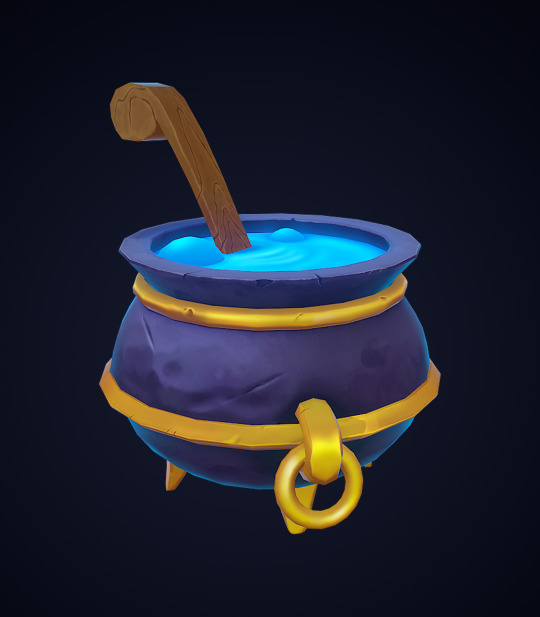

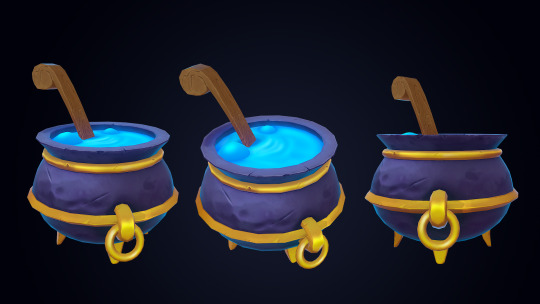
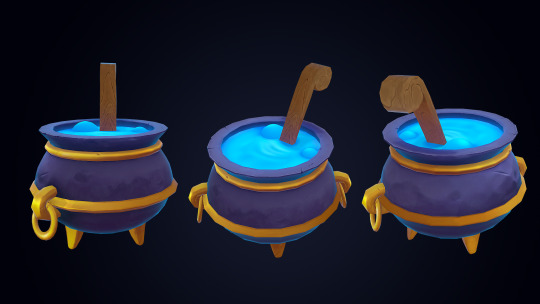

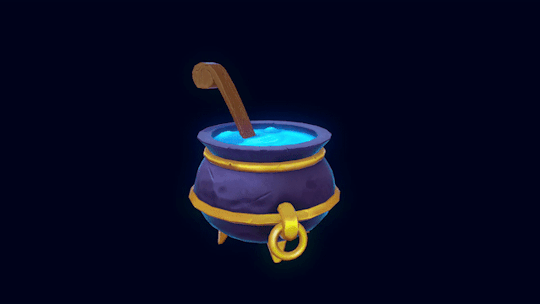
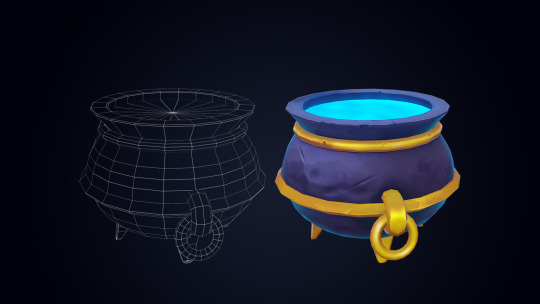
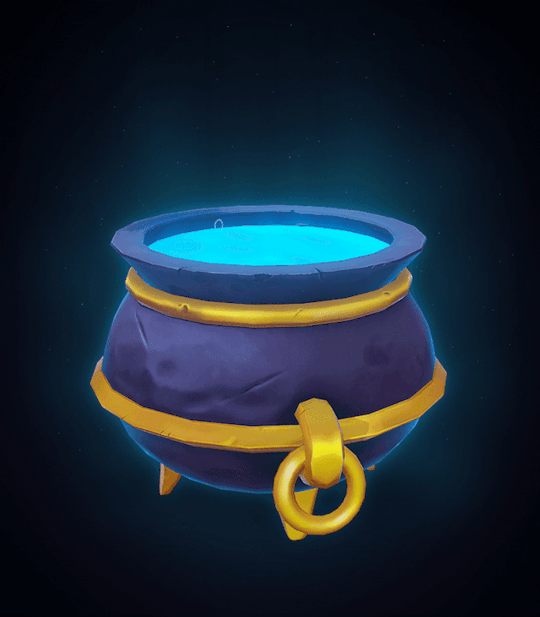
“Cauldron”
... Double, double toil and trouble, Fire burn and cauldron bubble...
---
I've been cooking up this mini side project in the background in between working on my main projects so I'm extremely glad to finally call it complete after all this time.
This is yet another experimental piece based on an original concept by 2D Artist: Natalia Theli.
If you wish to see more of Natalia's amazing work, please check out her full portfolio over on Artstation:
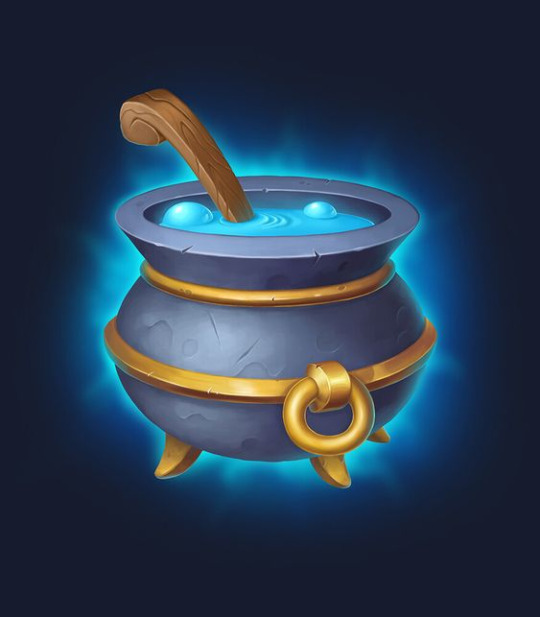
I first discovered this concept over on Pinterest and couldn't resist using it to experiment with a few new techniques that I've been meaning to try out in my 3D workflow.
Techniques such as:
Using Zbrush more in my process. I don’t usually use Zbrush much in my personal projects; however since I’ve been working more with it for my current freelance gig, I’ve truly come to see the value of incorporating it into the stylized texture creation process and now I’m inspired to try to use it more in my own work.
Creating hand-painting textures using the new Adobe Substance 3D Painter as an upgrade from my previous 2021 version of Substance Painter.
And lastly, applying 2D animated effects over renders of my 3D models in Photoshop to create my first mixed media piece, blending 3D with 2D.
As a creative who came from a 2D illustrative background as digital artist before delving into 3D art, you can say that lately I've found myself being drawn into playing around with ways that I can marry both aspects of my style.
It is for this reason why I enjoy art and mediums that combine 3D and 2D elements together. It's why I found movies and series such as RWBY, Into the Spiderverse, Klaus, The Dragon Prince, and the recent Arcane all so fascinating. Each, in their own way, have transcended what one can truly achieve when you combine 3D and 2D together to create something so masterful and beautiful that perfectly encapsulates the appeal of both styles.
Not like I'm saying that this is squiggly 3D wizard is planning to make the next Arcane. Not in the slightest. However I've always been an ambitious lil squiggle meister, never afraid to try something new in the name of creativity even it means stepping out of my comfort zone for a bit or working with something I'm no master of.
To be fair, it has been donkey years since I've flexed my 2D animation skills since I honestly fell out of love with practicing 2D animation since I finished animation school back in 2012.
Nonetheless, despite not counting myself as an animator, I've still retained an interest in the style and doing this mini experiment was a nice little refresher.
I mean...sure...it ain't anything too mind-blowing and fancy compared to the more seasoned 2D animation beasts of the world. However; for what's it worth, this lil assignment definitely sold the effect I wanted to capture.
Not saying that I'll be working strictly with 2D animation in my 3D works moving forward. I'm more saying, it's definitely another form of stylized art that I definitely wouldn't mind dabbling with from time to time.
I mean, after all; as someone with digital illustration, 2D animation and 3D modeling and texturing under her belt, if I can seriously discover new and cool ways to utilize these skills together to create something cool in the name of art then why not, am I right? XD
Overall, the end results of this mini project proved more promising than I anticipated and on that note, I can't wait to hopefully play around with this type of art style again down the line.
—
Tools Used: Maya 2020.4 | Zbrush 2022 | Adobe Substance 3D Painter | Photoshop CC 2018 | Marmoset Toolbag 4
———————————————————————————————————
~SC (2022)
#art of littlemissquiggles#squiggly 3D: mixed media project#handpainted#substance painter#made with: marmoset toolbag 4#photoshop cc#game art animation#mixed media: prop
17 notes
·
View notes
Text
Annotated Bibliography
1. García, J. and Murillo, C. (2020), "Sports video games participation: what can we learn for esports?", Sport, Business and Management, Vol. 10 No. 2, pp. 169-185. [Accessed Dec 6, 2020]
This article by Jaume García & Carles Murillo examines three concerns related to playing esports video games: the profile of participants in these games and their interests, their complementarity with traditional sports, and their perception of these games as a sport. The authors aim to contribute to the observed literature on sports video games and esports by offering data using various procedures concerning the notion of esports as a sport. These examinations are accomplished by applying the Survey of Sporting Habits in Spain 2015, produced by the Spanish Higher Sports Council (Ministry of Education, Culture and Sport, 2016).
As an esport gamer myself, I find the article engrossing and informative for my research. Understanding these studies will be useful in my practice as it will help me realise the influence of the expanding trend of esports on the sports industry as well as the video games industry.
2. Roettl, J. and Terlutter, R. (2018). The Same Video Game in 2D, 3D or Virtual Reality – How Does Technology Impact Game Evaluation and Brand placements? PLOS ONE, 13(7), p.e0200724. [Accessed Dec 1, 2020].
This article examines the experience of the players of an identical video game played in different modes, 2D, 3D and VR. The three variables the authors focus on for this research are presence, attitude towards the video game and arousal while playing video games. The research also focuses on the effects on brands placed in video games. For this, the authors analyse factors such as attitude towards the placed brands and remembrance for the placed brands.
I find the article useful for my study as it reflects the assessment of video games and the brand placements by analysing players' responses towards a 2D, 3D and a VR video game. This will help me gain knowledge about the advantages and the disadvantages, which I can use to reduce the harm to a game's rating.
3. Kowert, R. and Thorsten Quandt (2015). The Video Game Debate Unravelling the Physical, Social, and Psychological Effects of Digital Games. 1st Edition ed. Routledge. Available at: “https://www-taylorfrancis-com.ezproxy.herts.ac.uk/books/e/9781315736495″. [Accessed Dec 3, 2020]
In this book, the international experts review the latest findings in the field of video games and weigh in on the physical, psychological and social effects of the video games. These authors clarify the questions and topics relating to the health hazard, the benefits, addiction, aggressive behaviours prompted by video games, and/or if we can use them as the learning aids.
I find this book useful for my study, as the authors try to shed light on the facts that have been discussed for a long period of time, yet has no proper argument to support or deny these facts. This will help me learn about topics such as the contribution of video games towards depression and how we can use these video games as teaching aids.
4. Nichols, H. (2017). How video games affect the brain. [online] Available at: “https://www.medicalnewstoday.com/articles/318345?c=12778751367″. [Accessed Dec 7, 2020]
This article by Hannah Nichols examines the evidence focusing on the effects of video games on the brain and the behaviour, and whether these effects are positive or negative. The author shares that more than 150 million people play video games regularly in the United States, of which 72 per cent players are aged 18 or above, and the average age of these players is 35. 71 per cent of these player's parents say that video games are having a positive influence. According to the study, video games have both positive effects (such as better attention, memory boost and enhancing cognitive ability) and negative effects (such as the risk of addiction, and internet gaming disorder). Nichols H asserts this is a fresh area which will require more research, and the topic will continue to be explored. I believe this research is relevant to me as I might find myself working with a studio on a project undertaking these topics and how we might boost this knowledge through video games.
5. Sutton, P. (2019). Weapon Production: Building, Texturing, Lighting. [online]. Available at: https://80.lv/articles/001agt-weapon-production-building-texturing-lighting/ [Accessed Jan 10, 2021].
This article is an interview with Patrick Sutton, who works as an Environment Artist at game development studio 343 Industries. P. Sutton has been a professional modeller for more than eight years now. In this interview, he hands out his reflections on the weapon production which covers modelling, texturing, and lighting weapons for game studios and the things they sometimes lack. Reflecting upon the measures I follow, I'm quite amazed how similar it is. The similarity makes me feel confident and assures I am on the right path to achieve my goal of working with the leading game studios in the upcoming years. One of the most important learning from this interview was the lighting techniques. I've struggled a bit sometimes to properly place lightings to make my model look at its best. Following the tips by P. Sutton, I'm sure I'll be able to overcome this and get myself improved for the game industry.
6. Resenberger-Loosmann, M. (2019). 3D Weapon Art Workflow. [online] Available at: https://80.lv/articles/3d-weapon-art-workflow/ [Accessed 10 Jan. 2021].
Malte Resenberger-Loosmann is a Weapon Artist, currently working as a Freelance 3d artist for Rocksteady Games. I found this article on 80.lv, an industry-leading online platform for game developers, and other artists. In this article, Malte Resenberger-Loosmann shared his workflow and covered loads of aspects such as low & high poly, UVs setup, steps involving Substance Painter, and using Marmoset to render. I developed an interest in this article as I am an aspiring weapon modeller, and we commonly share a keen interest in hard surface modelling. To strengthen my technical skills, I always seek to learn from a professional. Following the methods used by the experts, I believe I'll be able to get myself equipped with a strong portfolio in a brief span. As for my individual technical development, I feel this is by far one of the most important articles I've come across.
7. Luban, P. (2021). Cyberpunk 2077 - Have video games become products like any other? [online] Available at: https://www.gamasutra.com/blogs/PascalLuban/20210105/375732/Cyberpunk_2077__Have_video_games_become_products_like_any_other.php [Accessed Jan 10, 2021].
In this article, Pascal Luban concentrates on the overall quality of the game & the consequences if it doesn't meet the expected level of quality. Luban P. is a freelance creative director and game designer and been working in the game industry since 1995 with major studios and publishers such as Activision, SCEE, Ubisoft and DICE. Luban P. feels CD Projekt Red had a severe encounter with the launch of AAA title, Cyberpunk 2077 as it is affected by too many bugs and was unable to function accurately on the latest gen consoles. I agree with the author. Unlike other products, we see the game's deficiency as a part of a player's suffering and find it normal to get a few gigabytes' updates (aka patches) to fix this. But what we don't realise is the loss of the player's playing experience. And this affects a studio's prominence. I find this article helpful as it gives me a game studio's working insight and the consequences a studio might have due to an affected AAA title.
8. Rowe, M.S. (2019). Boundary Work and Early Careers in Design and Media. Poetics, 72, pp.70–80. [Accessed Jan 10, 2021]
This article by Matthew S. Rowe explores the unpredictable conditions faced by emerging professional artists in the creative field. The article highlights the prevalent tension between art and commerce in creative work outlines a cultural difference to which these workers situates themselves to clashing work experiences. An interview of 55 graphics designers & digital media artists was conducted concerning their early-career developments. The findings demonstrate how these artists working in commercial fields use segmentation and integration as a way to define and explain their work experience. The author asserts that boundary work is a very useful theory if one desires to understand the early career experience. I chose to read this article to search and to understand more about the career and its possibilities for me in the future.
9. Zagała, K. and Strzelecki, A. (2019). eSports Evolution in Football Game Series. Physical Culture and Sport. Studies and Research. [Accessed Dec 9, 2020]
This article focusses on the subject surrounding online games and competitions. The authors attempt to studying the esports platform, with an example of the FIFA game series. The study shows the participation of 452 gamers, of which most of them consider esport as an actual sport. During this study, the authors explore the online gaming platform, with around 2.36 billion players in 2018. I feel the development of the gaming industry over the years was justified by the numbers of active players. As an active FIFA player myself, I find this study quite impressive and a great way to learn about the important aspects of a game which keeps a player involved. This will also help me keep up with the current FIFA affairs of the ever-expanding video game industry.
10. Gill Hasson (2019). Communication: How to Connect with Anyone. [online] Available at: https://learning.oreilly.com/library/view/communication/9780857087508/ [Accessed Jan 10, 2021].
The author of the book concentrates on communication, one of the most basic & important, yet complex skills of an individual, and the issues that contribute to miscommunication. Miscommunication in the workplace can harm confidence, productivity and the working relationships between multiple departments. Hasson G. emphasis on positive communication, and the ways to recognise and overcome the obstacles of miscommunication. The is an exciting book, especially for someone like me, an international student, where communication plays a vital role in my everyday life. Referring to the book, I feel I can use it to develop myself to avoid miscommunication and be able to communicate effectively & acutely not only today but also once I start working in the future.
2 notes
·
View notes
Text
I Don't Believe In Magic
A continuation of my Clextober universe. I Don't Believe in Magic is set in the College time of Clexa. I'm always accepting more prompts!
---
Lexa drew circles in her notebook with her right hand while her left supported her lazy head. She sighed and flipped the page as the lecturer continued to drone on about mythology. She didn't even know why she took this class. It was a joke in one aspect - listening to humans blather on about mythical beings and how eerie and strange they appeared in comparison to their human counterparts - but another part of her longed to find some similarities between herself and the humans.
She easily found one - they were terrified of one another.
Lexa just didn't understand why.
Her father had scolded her time and time again for being careless with her magic, giving herself away to humans. "You can only rewind someone's memories so often before you run into trouble, Alexandria."
But, Lexa always had a soft spot for humans - always interested in the way they perceived the world and knew that deep down they were more alike than they knew. So, denounced her family tradition of attending the top wizarding school in the world, and accepted the soccer scholarship offered to her by Arkadia University.
***
Clarke Griffin was on a mission. Her last name carried the power of a world-saving doctor. Unfortunately, it also carried the expectations. But Clarke was always known to defy expectations.
That's why she wanted to go above and beyond her mother's medical degree, and double major in both medicine and art.
It was her greatest ambition.
It was also her stupidest idea.
Because, at eight in the morning, when Clarke could have been sleeping before her three hour Animal Kingdom lab, she was stuck in this stupid Mythology 101 class, learning about creatures that never existed and paintings that didn't capture anything of substance.
She wondered how high some of these painters were when they painted these things. Because scientifically speaking, there was no way a woman could take an inanimate object, like a broom, and create enough velocity and speed to have it fly.
Clarke was a woman of science. She had seen her father beat death twice, all due to the medical advancements of man. Sure, hundreds of years ago it would have been seen as witchcraft, but she was positive that the only magical beings were the things that weren't researched.
She sighed, rubbed her eyes as the sigh turned into a yawn, and flipped the page of her agenda, scheduling her free time into her already packed schedule.
***
"Excuse me, I understand that as a society, we've always been a bit spooked by the unknown, but it just seems like the entire concept of witches were solely based on repressing women. I mean, Medusa only turned the men that raped her into stone, but she's spoken of like a villain. Women who showed any sort of forward thinking in Salem were hunted down for witchcraft. I think that maybe we should be discussing the mental health of the accusers than the 'magical powers' of the accused."
Lexa's ears perked up at the husky voice in the midst of destroying the lecturers current argument. Not that she knew what it was, zoning out into a state of semi-consciousness as the monotonous voice of the lecturer carried on.
She looked across the room, noting the long blonde hair and dark blue leather jacket sitting in the front row. She felt her heart do a funny thing then - it beat with a staccato rhythm, every pound precise as she gazed at the girl.
The beating of her heart was so loud that the rest of the argument was lost to the sharp beat in her ears.
Before she could snap her fingers to bring herself closer, the lecturer had dismissed the class, and the blonde was the first one out of her seat.
Lexa grumbled, wishing that at this moment she could snap her fingers to catch up to the blonde. Instead, she had to hustle down the stairs from the back of the class, her shoulder bag flopping against her bare leg.
She caught her just as she had stepped out of the building. "Hey!" Lexa said.
The blonde didn't turn around. Lexa ran past her and came to a stop just in front, doubled over and gasping for breath. She held her hand up to the blonde to ask her to wait.
"I really don't have time for this," Clarke sighed.
"I just -," Lexa gasped. "I wanted to - whoo," she panted, "I wanted to tell you that I liked what you said back there."
Clarke quirked a brow.
"About witch hunting."
"Oh," Clarke laughed. She let her eyes trail up and down Lexa's lithe figure, noting the purple soccer shirt she wore and the short soccer shorts that left little to the imagination. "No one really believes in that stuff anyway. Witches? Goblins? It's just stuff parents tell their kids to behave."
"Maybe we could discuss that? Over coffee?" Lexa asked.
Clarke's grip tightened on her bookbag. "Thanks, but I don't believe in magic. It was nice meeting you…" she trailed off, waiting for the brunette to say her name.
"Lexa, and you will."
"Lexa," Clarke repeated. "It was nice meeting you. See you next week." And with that, the blonde was off.
"Is that the face of a girl who has been sorely rejected?" The dark figure asked as it stepped out of the shadows of the building.
"I'd ask you how much you heard, but I know you're a lurker," Lexa replied, not bothering to look over her shoulder and acknowledge her sister.
Anya laughed and slapped her sister on the back. "I'm not a lurker, I just happened to leave class at the same time. She's cute."
"She's human," Lexa said.
"And yet, that's never bothered you."
"Of course not," Lexa said with a cheeky smirk.
***
"Oh my God," Raven gasped.
Clarke looked up from her notes for a second to check that her friend was okay.
"Who is that hottie? How have I never seen her before?"
Clarke glanced over her shoulder, much to Raven's protest. "Don't look! Oh my God, you make it so obvious!"
The only person Clarke saw was the long brown hair of the soccer player in her class - Lexa.
"Lexa?" She asked her best friend. "The brunette?"
"Screw the brunette, I mean the blonde sitting with her!" Raven said. "She's hot."
"They're both hot," Clarke commented offhandedly. "They're probably together."
Almost as if being summoned, Lexa and her companion stood from their table and walked towards Clarke and Raven.
"Be natural, but they're headed this way," Raven said. She adjusted her posture to sit up taller, pushing her chest out.
"Totally natural," Clarke teased. She bowed her head just slightly, pretending to be deep into her work. For some ungodly reason, the idea that Lexa was walking towards her was unsettling.
"Hey Clarke," Lexa said, stopping by the table. She adjusted the strap of her satchel on her shoulder. She held a regal posture, swagger and confidence seeping from her core. "What's up?"
Clarke looked at her, stunned by the intensity of the green eyes - ethereal in their beauty. She hadn't seen a pair of eyes quite that colour - as though it was constantly shifting when she finally found the name to match the shade. They were light at first, but the longer Clarke stared, the darker they appeared.
"Oh, hey, um…" She was so taken aback by the girl's eyes that she fumbled over her name.
"Lexa," Lexa answered for her. The quirk of her lips disappeared at the rejection. Her eyes shifted to a sharp green before they dropped to her shoes. Her cheeks turned red in embarrassment. "I um," she shook her head. "Nevermind."
Anya cleared her throat.
Embarrassed that the girl she hadn't stopped thinking about could barely remember her, Lexa swung her bag wildly to knock the pile of books in front of Raven to the floor and hustled off, her cheeks hot with embarrassment.
"Hey!" Raven yelled after her.
Lexa got all the way to the parking lot before the sound of the raspy voice she was enamored with got her to slow down.
"Hey!" Clarke yelled. "Lexa!"
Lexa stopped walking, pulling in a deep breath into her chest. Lexa Woods was better than some silly embarrassment. She turned, cocky smile on her lips and ready to greet Clarke again, but anything she had been planning disappeared with a sharp pang in her cheek and a hollow thud only she could hear.
She fell back onto her butt, her outstretched arms the only thing stopping her from hitting her head.
"You know, you're such a dick. Bullying someone with a disability isn't going to make me want to be your friend! You may be the school sweetheart because you can kick a ball, but Raven is so much more than you'll ever be."
Lexa gaped at the blonde, confused by her words and impressed by the ache in her jaw.
"Just leave me alone, and don't you ever put your hands on Raven or her things ever again!" She turned and stormed away before Lexa could even get a word in.
***
"You're a genius!" Anya sighed, throwing her bag onto the counter of her shared apartment with Lexa.
"Yay," Lexa said sarcastically.
Anya pouted down at her sister and flopped down onto the couch beside her. She flicked her wrist and an ice bag hit Lexa in the face.
"Ouch," Lexa whined. She adjusted it to press against the blossoming bruise she had received from Clarke.
"Raven's human, but the science she used to fuse her spine and create that brace to allow her to walk is practically magic. She's so open minded. Not to mention, beautiful. She and I are going out tomorrow."
Lexa sighed and smiled at her sister. "I'm happy for you."
"I'm sorry Blondie KO'd you. I cleared it all up and told her that you were just incredibly clumsy."
Lexa shrugged.
***
"Hey," Lexa said to the blonde as she entered her Mythology class. She wanted to clear the air and apologize to Raven. "Listen, about yesterday - I didn't -"
"I know," Clarke sighed. "Raven already yelled at me. I'm a little overprotective. Sorry about the left hook."
Lexa smiled down at the girl, and shifted her satchel. "I think it's hot," she said. Her eyes widened, and she looked away, her cheeks dusting pink at her slip.
"Well " Clarke said, pulling at the edge of her textbook, "I'm really sorry. I thought you did it on purpose."
"I did," Lexa answered, nodding at the blonde, "but not for the reasons you think."
Clarke quirked a brow.
"My sister wanted to meet Raven. I had promised to introduce her, but you couldn't remember my name and I was embarrassed. But, I never break a promise, so," Lexa shrugged one shoulder.
Clarke looked down at her text. "Yeah," she breathed.
The lecturer walked in at that moment, and Lexa sent one last look at the girl before heading up the auditorium steps to her seat.
She spent the entire class picturing blonde hair and blue eyes.
***
"Hey, Lexa?" Clarke called out to her as they exited the building. It was pouring rain, most students huddling under the awning as they prepared to race to their next class.
Lexa turned and smiled at the blonde. Clarke was struck again by her beauty. "What a miserable day," she said. "It'd be a good day for a warm drink."
Lexa might have had a witty response if she weren't so preoccupied of the way the little clouds of condensation curled out of Clarke's lips when she spoke.
Clarke chuckled. "About that coffee," she said, hands tightening on her textbooks. " I have eighteen minutes until I have to get to my next class. Would you like to join me?"
Lexa smiled and Clarke blinked rapidly, swearing she saw the green of her eyes shift to a lighter shade.
"Do you feel that?" She asked Clarke.
"Feel what?" Clarke asked, unable to pull her gaze from the brunette even as the girl stepped out into the rain. She was thoroughly soaked when she turned back to Clarke.
Her smile was blinding in it's intensity. "The magic in the air."
"I don't believe in magic," Clarke called, cheeky smile on her lips.
Lexa ran back up the steps next to her and produced an umbrella seemingly out of nowhere with her clothes remarkably dry.
"You will."
#alycia debnam carey#13daysofclexa#lexadeservedbetter#the 100 lexa#the 100 clexa#clarke griffin#clextober19#magic#accidental magic#modern magic#magic!au#magic prompts#witch!lexa#clarkegriffin#clarke#clarke x lexa#the 100 clarke#commander lexa#lexathe100#lexa kom trikru
99 notes
·
View notes
Audio
Art is somewhat hard to understand its concept from some, and no wonder because the misinformation about this term has been promoted. And because of that, there’s a constant debate about the topic.

Art is not a personal concept. When we talk about art, we’re not talking about tastes, but a discipline. And like any other discipline, it takes some logic and reasoning. I want to make sure why is there the mistake that art is ambiguous when it’s pretty clear. There are two categories about the definitions of art or preferably two ways to see art.
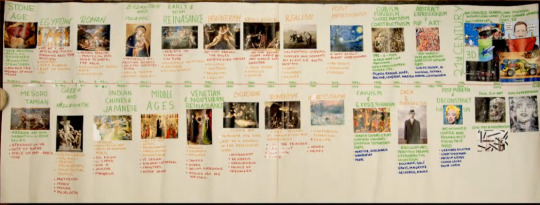
There’s the belief that art has an objective definition and the view that art is something personal. The 1st definition I’m mentioning appeared first, and because of that, it’ll be the one I’m talking about first.

While the artistic expression has existed since the first steps of humanity, that definition was given by old schools and when society stabilised art as a discipline because it never was considered as such.

METAPEDIA (100% trustworthy) Art is the use of ability or imagination in the creation of aesthetic objects, environments or experiences that can be shared with others. Artistic pieces are the materialisation of human feelings, ideas or a worldview, that being carried to others, have the faculty to enrich their personalities. A town’s art is part of its culture and reflects its customs, believes and behaviours. Spanish Wikipedia (Not my cup of tea)
Art (From Latin ars, artis, and Greek τέχνη téchnē) is generally understood as any activity or product made with an aesthetic and also communicational purpose, where they express ideas, emotions and in general, a worldview through a diversity of resources, like sculptural, linguistic, resonant, corporal and mixed ones.
Definición.de Art (From Latin, ars) is the concept that encompasses all creations made by the human being to express a sensitive vision about the world, either real or imaginary. Through sculptural, linguistic or resonant resources, art allows expressing ideas, emotions, perceptions and sensations.
If we go to different sources, the definition is written with different words, but the idea is the same. Art is about material or experience of aesthetic nature, that materialises thoughts and feelings; and can be shared with others to enrich the personality.

Concept
The definition of art is open, subjective and debatable. There is no unanimous agreement between historians, philosophers or artists. Over time, there have been numerous definitions of art, including: “art is the right order of reason” (Thomas Aquinas); “Art is that which establishes its own rule” (Schiller); “Art is style” (Max Dvořák); “Art is the expression of society” (John Ruskin); “Art is the freedom of genius” (Adolf Loos); “Art is the idea” (Marcel Duchamp); “Art is the novelty” (Jean Dubuffet); "Art is action, life” (Joseph Beuys); “Art is everything that men call art” (Dino Formaggio); “Art is the lie that helps us see the truth” (Pablo Picasso) ; “Art is life, life is art (Wolf Vostell)”. The concept has changed over time: until the Renaissance, art was only considered the liberal arts; architecture, sculpture and painting were “crafts.” Art has always been one of the primary means of expression of the human being, through which it expresses its ideas and feelings, the way it relates to the world. Its function can vary from the most practical to the most ornamental; it can have religious or merely aesthetic content; it can be durable or transient. In the 20th century, even the material substrate was lost: Beuys said that life is a means of artistic expression, highlighting the vital aspect, the action. Thus, everyone is capable of being an artist.
The term art comes from the Latin ars and is the equivalent of the Greek term τέχνη (téchne, from which ‘technique’ comes from). Originally it applied to all man-made production and disciplines of know-how. Thus, artists were as much the cook, the gardener or the builder, as the painter or the poet. Over time, the Latin derivation (ars -> art) was used to designate the disciplines related to the arts of the aesthetic and the emotional. And the Greek derivation (téchne -> technical) for those disciplines that have to do with intellectual productions and articles of use. At present, it is difficult to find that both terms (art and technique) are confused or used as synonyms.
Attributes of Painting, Sculpture and Architecture (1769), by Anna Vallayer-Coster
What I don’t like about the Wikipedia article is that it contradicts itself. It starts with a clear definition with no ambiguities; later, it says that art is subjective because there’s not a consensus about its definition. That is because many experts have different ideas about what art is, which it’s absurd because the fact that someone understands something differently doesn’t deny the truth. It’s like saying that I understand math differently and mathematics have different interpretations, in other words, they’re subjective, which it’s ridiculous. Many examples of opposite ideas that Wikipedia put as an example don’t contradict each other. Because they are straightforward ideas, at most an expert prioritises more thought than another one. It’s not like one of them said that art could be anything, what is ugly or a person. They got certainty about what is more important in art, not that art is each thing.
Let’s analyse why the given definition makes sense, breaking down the features that compose it:

1. Art refers to some material or experience with an aesthetic character:
That makes sense because it’s aesthetic; it makes it striking and presentable; also, it reflects effort. And reflecting something that requires effort it gives a meaning that art is a job, I mean if it’s not a job and anyone can do it, then why would there be artist or experts in the first place? Besides, if we take out the aesthetic feature in the definition, then horrible and harmful things would be considered art.

2. It materialises ideas and feelings:
That tells us that one of the foundations of art is it has to have a communicational function, I mean, art must have a meaning. That makes sense because if art has no meaning, what’s the point of doing it? So you can admire it? Why admiring it? What are your reasons to admire it if it doesn’t mean anything? Let’s leave out the communicational function of the definition. It has room to the fact that if something is beautiful, then it’s art. Beauty has a very high rank, so it would make the definition ambiguous.

3. It can be shared to enrich the personality: That’s extremely important because it gives art a purpose; every discipline must have a purpose. It’s part of the concept of the field; I mean schools exist to educate, science exists to make life easier and preserve the species. Science is a discipline, and art just like science has a purpose; to enrich the personality. Through art, you think, you learn something new. As said earlier, art is a materialisation of ideas and feelings, and that’s why consuming art is good. With art, you learn, art is emotional intelligence. Art just like science is something that has its reason to be, its logic; it’s merely another kind of logic, another type of intelligence.
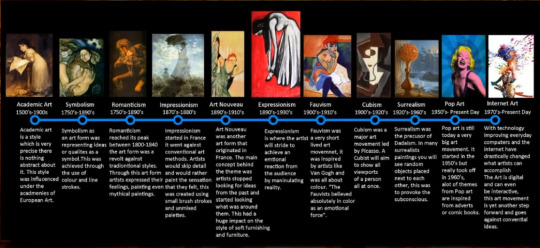
The 2nd definition of art is something personal, and so; subjective appears after 1884 when the artistic movement; The Impressionism, which it was contemptuously criticised back then; was active. The impressionists, in defence of the critiques they got, they forced the idea that “Beauty was in the eyes of the beholder.”
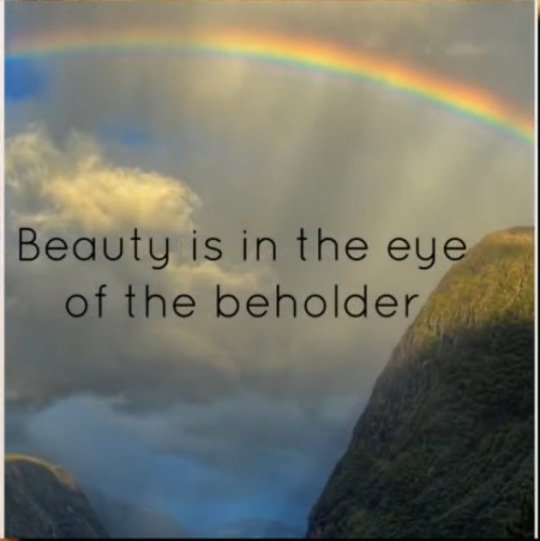
That’s absurd to me because as I explained earlier, not just because someone has a different take, it doesn’t mean that an objective or relative truth cannot exist. I mean, you can say a sickness can be beautiful, but the thing is no matter how much you want to bend reality, it’s a fact that an illness is not beautiful in any way.

While I respect the impressionist movement to a certain point, and I respect its ideology to sacrifice complexity to leave colours to transmit emotions. I do consider that its new subjectivist definition of art was a terrible misfortune, because of that there’s a lot of confusion with a term that easily was well-defined through centuries. Not only that way of thinking brought lots of notoriously inferior artistic movements like Cubism.
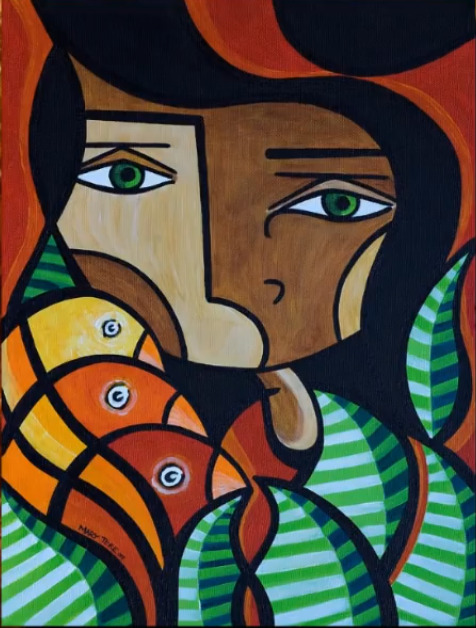
In a nutshell, it’s a mediocre way of thinking that brought with itself misinformation, a decline of the idea of art, and a drop of quality.
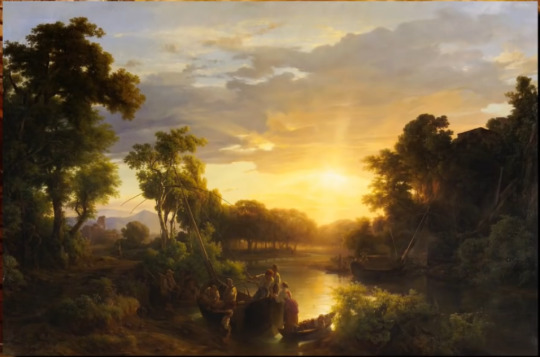
My point reinforces with a simple comparison; you have to compare the works that were created with an objective definition of art, with the ones with a subjective definition.
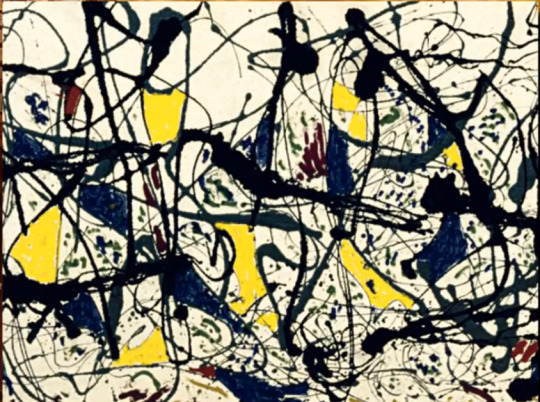
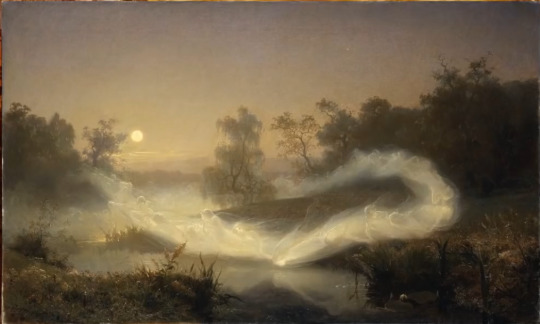
Think for a moment how well-defined was the first definition, and how it demanded higher standards. Turning out in more outstanding excellence and compare it with the problems and ambiguities that brings the 2nd definition.

According to the ambiguous 2nd definition, art itself is ambiguous; then anything can be considered as art. It all depends on how it’s seen. If that’s true, it promotes overthinking; in other words, pretentiousness. You are praising something for its lack of content or its confusing/contradictory content. On the other hand, if we omit many features of the 1st definition, the idea of arts stops making sense. Let’s say art for some is what is beautiful, but it’s not necessary to be communicational. That means art lacks substance, and then painting green a wall is art, because the colour is beautiful.

If presenting just a beautiful colour is art, then it doesn’t make sense trying hard to create something with substance. Because a painting that took you days to perfect will be as praised as an empty portrait with no meaning.
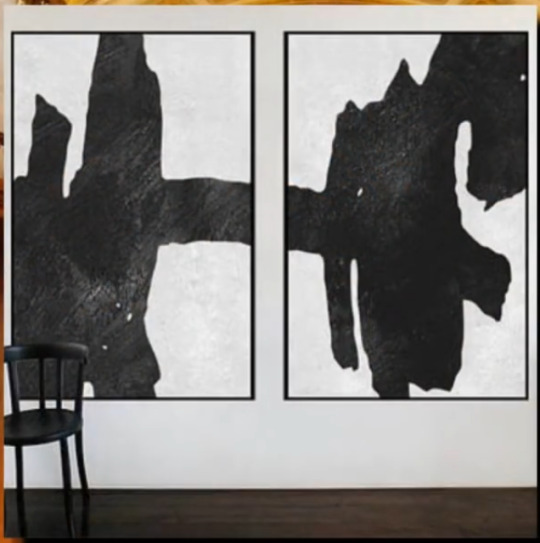
Let’s consider art to be transmitting something, in other words, having a communicational function. Still, our message doesn’t need to be beautiful nor aesthetic. We’re saying that things like wishing death to somebody can be considered as art, or just communicating anything is art; even a conversation.

There’s a reason why a political speech shouldn’t be considered as art. The political address is communicational and discipline, but not an artistic one. I could go on for hours explaining why it doesn’t make sense to have a very flexible definition of art, and why the first one has better results.
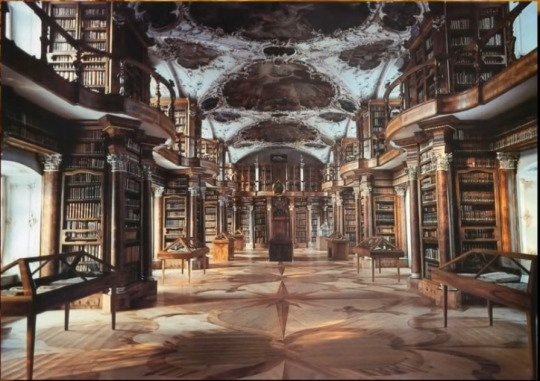
The first one never created a creative standstill nor restricted the artists. It helps them to push themselves and reach excellence; the praise of their people aided them to create culture.
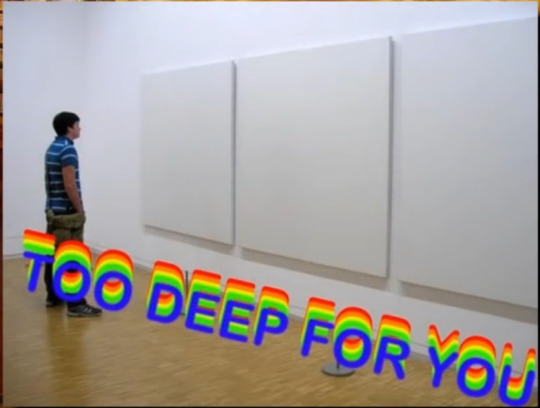
What is too abstract loses all meaning as art. I’m not saying that art shouldn’t have an ambiguous character in certain aspects, after all. As I said in the past, subtlety is one of the most of import components in good work. The difference between an ancient artwork and modern art nonsense is that the first one counts with recognisable elements that give you tools to interpret. While modern art is so abstract, that it’s not made up of anything, I mean, it’s not like it’s hard to understand, you’re so pretentious, that you see messages where there’s none. The work was done like that on purpose so people can fill the empty voids instead of taking credit from that job to the author, who has no conviction in what they want to express.

Minimalism is not a type of artistic technique; it’s a type of design. It works well, and it’s attractive for advertising or to spread information, not to have a pragmatic and crucial message because minimal art lacks eloquence.

The only thing that our free and modern definition of art is doing is to create confusion, lower the standards, and to ridicule the name of art. It’s because of things like a man taking a shit can be considered a piece of art nowadays, people who don’t know about art; dimmish its value. That’s why people don’t see art as a World Heritage Site, and it’s as important as science. And that’s why people who want to be artists to suffer, because their parents don’t want them to be artists. Because they consider something artistic work as a ridiculous job and has lesser value than other jobs.

We must start to understand what genuinely is art. We must begin to understand its importance, its work. We must change the popular mindset about art. When people see art is work, that it requires effort, dedication, sweat and tears. That art is quality work, and that is not something that is just held to personal perception, or taste. It’ll be the time when people will start respecting art again. Maybe then, the fans will be more demanding, business people will abide by franchises more. And they’ll set out to see that in the entertainment world there’s not just entertainment, but also art.
-

We all know at this time and age whoever judges art with a postmodernist view is an idiot and a spoiled brat. I’m not going to argue with hicks anymore about something that they’re not interested in. Instead, I’ll address to people who are genuinely interested in art, no matter their reasons for their interest. Especially I’ll address to a group who is following and having me in mind.

So, my brothers, believe it or not, art can say more about the state of a society than a thousand words.

I have the hard belief that one sees GOOD art when a society is good and healthy.
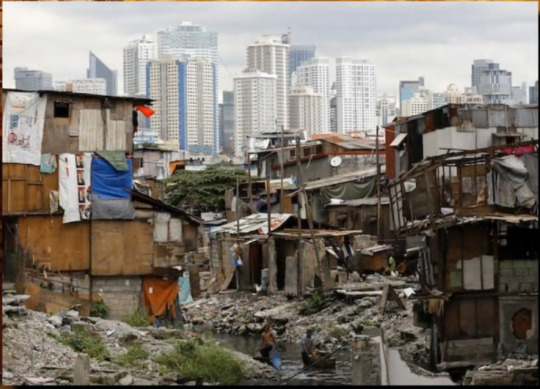
And one sees bad art when a society that is not very intelligent or diseased.

After years of studying and being interested in the world’s history, this funny pattern repeats with no exception whatsoever. It’s by far one of the best ways to judge the quality of a nation.


Even though you want to believe it’s an issue about money, the truth is that it’s not the case. I want to point out that a wealthy society can produce art, that art is degenerate, sick and anti-nation.

That should not be surprising because art is the reflection of a person’s soul and spirit level. Degenerate art reflects a sick society and a disloyal state. Anyways, why is producing art so important anyway? My idea of saving the world has to do with anything artistic-wise.

As this curious study shows, our shitty modern buildings make us depressed, and no wonder.

They’re grey, similar and dull.


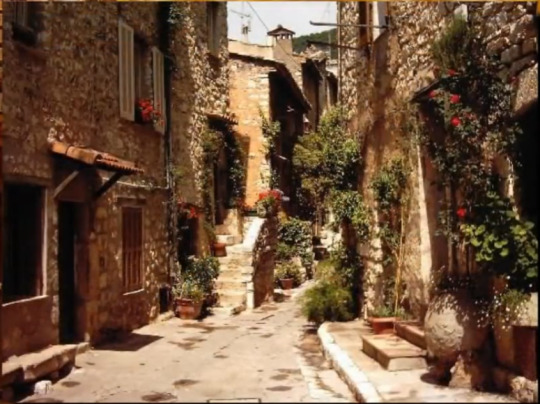
Capitalism and globalism destroyed that magic.
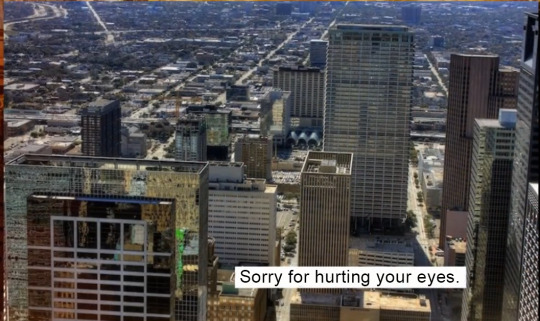
In ancient times, we were leaving our homes with excitement because we were feeling inspired by our surroundings.


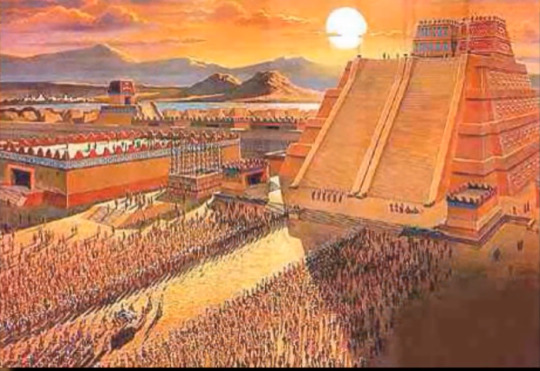
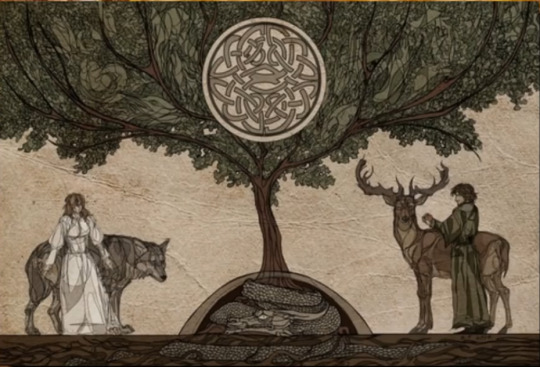

Instead, now most people are doing jackshit and repeating a depressive routine.
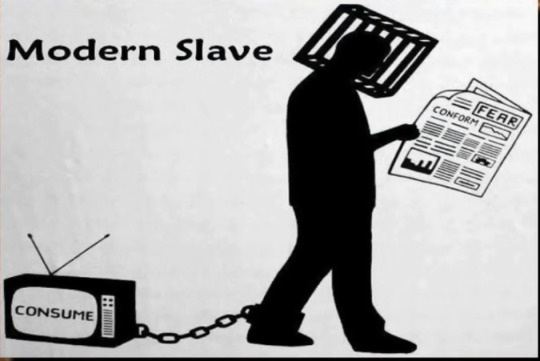
In ancient times, our ancestors were admiring and praising the stars as their gods.

Now you can’t even see a single star because there is smog.

It’s like that simple joke of “Retro Always Wins” was never a joke, but actual reality. Not only art is getting shittier; life itself gets even shittier. Horrible shit happens every day, but nobody cares. Horrible shit occurred in ancient times, but people were inspired and giving their lives away. They cared about things, and they weren’t sedated in front of a screen. Modernity made us weak and epicurean. I’m not too fond of the modern world, and I’d love even to be a miserable hobo if I had the chance to live in those magnificent times. To be surrounded by those beautiful castles, that fine music. At the same time, I can see little kids playing outside.
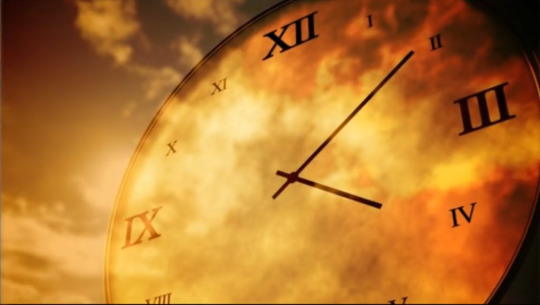
Even the CIA admitted that the elites manipulated art to control your emotions. Typical from this disgusting modernity, nobody gives a fuck, nobody complains, nobody talks about it. We accepted our fate as an uninspired herd with no ambitions. We don’t have art to inspire us anymore. However, we got stupid entertainment that makes us temporarily happy to stay still, immobile and inactive. In a nutshell; we reached the point that it’s completely useless.

Or isn’t it? I understand why people don’t listen to me because many turn down my message and because they sense me as a lunatic or excentric. After all, I’m not someone to be considered as normal. What moves my gears is something different. If at the end I will die and so will the universe and nobody has no certainty about what will happen next. Then why worry about all this shit about values, beauty or inspiration?

Because it feels right for me, when I was a kid, one person who used to make me happy was my grandfather. He’s part of why I started liking cartoons a lot. He used to tell me cool stories and made impressions of cartoon characters to make me laugh. I never met such a joyful and full of energy person like him in my life. He always inspired me, telling me his stories and showing me how strong he was. One day… he just got cancer, my grandpa was going to die, and while I was sad about it, I was too weak to face reality. I sometimes wanted to escape and not thinking of sad stuff. I made so many hedonistic things at the time. I couldn’t look at my grandfather because he’s just wasn’t the same, all that jolliness was just gone. My grandfather died, I didn’t dare to say goodbye, and that’s why I hate hedonism, and I love fascinating and beautiful art.

Hedonism weakens us, and we always know it when we fall into it. Instead, art or even good entertainment inspires and join us together.

That’s why I promised myself never to lose my spirit, no matter how most people see me; I will be me—doing crazy things, taking risks. The victory means finding a superior status, and defeat means finding death. There won’t be in-betweens for me; I’ll be eternally inspired, even in the eyes of death. No cancer will change that, not even the cancer of modernity.
3 notes
·
View notes
Note
You are a source of inspiration..Any recommendations if someone wanted to make a game of their own? (I.e what programs to use, things to look out for, etc)
I’ll get the expected answers out first. Here’s the programs I use (and the plugins I use for each of those):
Blender, which I use for modeling, rigging, and animating
Rigify plugin for rig creation (this comes bundled with Blender, you just have to enable it)
RetopoFlow for retopologizing high-poly to low-poly (has a free version in Github, the paid version just entitles you to technical support)
Substance Painter for texturing (this sometimes goes on sale on Steam, so watch out for it every time Steam goes on a discount sale)
Photoshop CC for creating GUI art, and image manipulation needs ($10 per month sounds fair for all the things it could do for me)
Unity for the game engine
StrangeIoC, an open-source code framework (I explain what it is exactly here)
TextMesh Pro for the GUI labels (free)
ShaderForge for making my own shaders (used to be paid, but it’s now free)
InControl, for user customization of controls (has an old, free version in github)
Unity’s Post-processing Stack for visual effects (free)
A custom AI plugin that I made, called INTLord
A custom game editing tool I made that I simply call Attack Editor (for now)
Visual Studio Community Edition (the free version) for the IDE
Resharper plugin for VS is immensely helpful for me (this is pretty expensive, but worth it for me as I use C# heavily)
Git for backup and version control
I use Git Extensions as the front-end GUI
Dropbox and Google Drive for backing up other things like raw art assets
Portable Kanban for keeping a todo list (I can recommend HacknPlan for an online alternative)
But I think the number one thing to look out for here is that, while it seems I’m able to do this game with ease, I can assure you that it is not smooth sailing all the time. I’m only sharing the end result of my work each time I post. All the mistakes and errors I encounter, I tend to discard and not share, but only because I think no one cares to really read about them. My point here is that even when I tell you what programs I use, just using those won’t guarantee you success.
If you’re having a hard time making a game, that doesn’t mean you’re not cut out for this, because I have a hard time too. It’s an inescapable part of something as complex as game development. I think what really makes a person not cut out for this, is when they give up easily when encountering difficult problems, like an overwhelmingly confusing bug, or getting a crash and finding out your work got corrupted. The proper response here is to approach problems methodically instead, and take steps so you tend to not encounter those things again in the future.
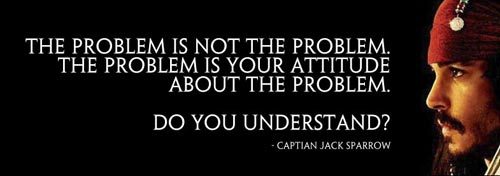
Don’t expect to get things perfectly the first time, but do take time and effort to improve each time you blunder.
There’s one pattern I see a lot with beginners who never get far: they love to complain. Don’t end up like that. If after all your best effort and research, things still don’t work, then I can finally concede that you have the right to complain.
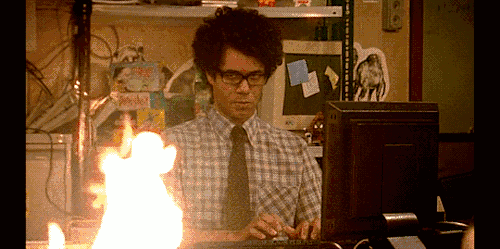
These beginners would blame the engine, the programming language, or the art tool if something goes haywire, when, majority of the time, the mistake was their misunderstanding what the tool was for, and a way to solve it was in the user manual. So make sure you’ve done your homework before going on a rant.
Second thing: Practice a lot. They build your skill set. If you have no idea where to start, I suggest just making a simple game like tic-tac-toe in the game engine of your choice. The point here isn’t to build something amazing, it’s to get your feet wet with the tools you’re using. You’ll be doing it more to learn how to get graphics drawn on the screen, how to detect and react to user-input, how to code gameplay logic, etc.
The fact that you’re making a simple tic-tac-toe game helps ease the difficulty curve of trying out a new game engine. Then work out how to put a main menu on it, a highscore that gets saved to a text file, etc.
Then try out making a tetris game, then a side-scrolling platformer, etc. The more familiar you get with your tools, the easier it is to create more and more complex things.
There’s a theory out there that the amount of vocabulary you have with your spoken language influences what you tend to say (or even think!). I think it’s the same with you and your gamedev tools. You might have never gotten around to doing some crazy idea you had, simply because, lacking knowledge in your tools, you didn’t think it was possible.
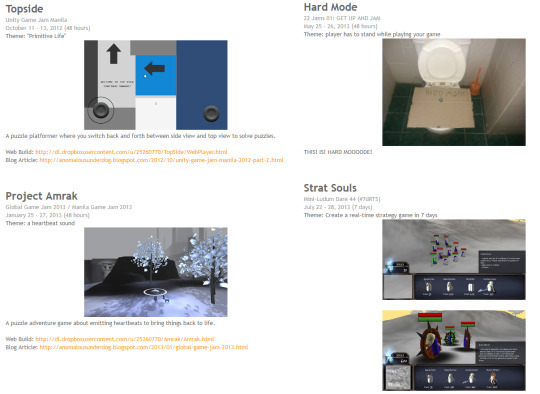
I do game jam games to try out learning something new.
One thing you need to realize is, if you’re not having fun doing the nitty-gritty details of these steps in game-making, maybe you should reconsider your choice of wanting to make games, because this is how it is all of the time. Or probably at least consider specializing in one aspect instead, and get help with the rest.
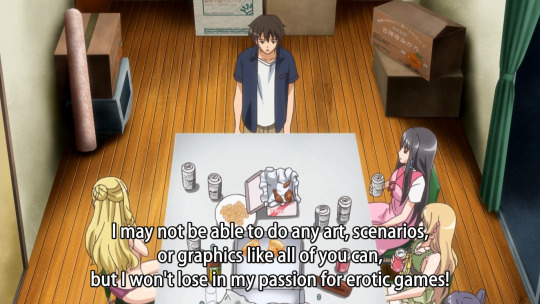
The third thing to look out for is having no direction. What really helped me out with making this game is having a clear goal of what I want: a 3d action game about the last days of a terminally-ill henshin hero, taking place in a modern day city.
When you have no clear goal, you have no idea if what you’re currently doing is beneficial or detrimental to your game. You would have no yardstick to measure progress.
It’s fine to experiment without having decided yet what the game will look like, or what genre you’re going for, but I think even among experiments, the good ones are those that have at least some general direction of what they’re trying to test or prove.
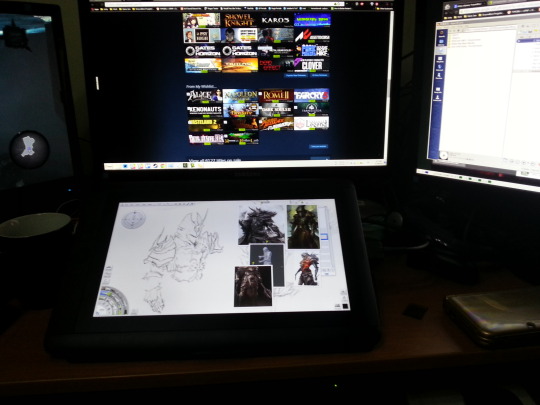
This is the earliest photo I could find of my work on the game, dated 2014, Dec. 31. On my pen tablet display there is my early concept for Desparo.
There’s a lot of things to consider when deciding to make a game. I myself was thinking whether I make this game a turn-based, or a real-time action RPG. I was also wondering if I should do it in 2d or 3d, if I go with anime or realistic art style, etc.
I knew I needed to finalize my decisions if I ever hope to progress. I think the proper way to have done it would have been to make a turn-based RPG prototype alongside an action RPG prototype, and then compare the two. But in the end I just went ahead with the real-time action game, simply because I wanted to try out something new.
Sometimes, you start out making a game prototype with just boxes, and deciding it has potential, flesh it out further by attaching a theme/story/premise behind it. I think that’s also a viable approach. It just so happened Ghost Knight Victis started the other way around, with the story first before the gameplay.
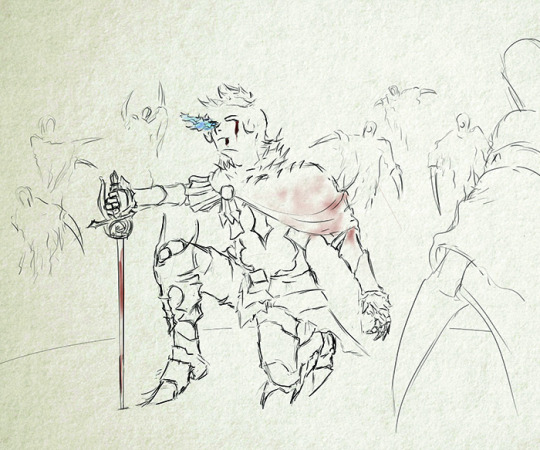
And how do you get that spark of an idea of what your game should be? My game’s premise was a culmination of several ideas that have been brewing in my mind for a long time (years). After going through something pretty significant in my life and one lonely December, with two bottles of Tequila and playing through Transistor, all the incongruent ideas started making sense and fit together.
I’m not saying people need to go beat themselves up just to get something “cool”. In fact, if you have a content and happy life, consider yourself lucky if you couldn’t find inspiration to create something really artistic. Because those things tend to come from some deeply-buried, strong feeling, like anger or resentment. Then again, dealing with such thoughts are a normal challenge of growing up, living in a community, or even something as mundane as struggling with where to get a stable income. You just need to change your perspective on where inspiration comes from.
Fourth is to pace yourself properly. Match your expectations with what you can do at the moment. Aim too far out of your comfort zone, and you’ll likely fail, get discouraged, and stop trying. The trick is to aim only a little bit outside your comfort zone. You still compel yourself to improve, but at the same time, it’s a manageable amount of work for you.
Scrum and Kanban are the usual things to learn about here. I personally use Kanban a lot. The idea is simple:

As a task gets further along to completion, the more it moves to the right. But, you have one restriction: only up to 3 tasks at a time can be in the “Doing” column.
This means if you are already devoted to working on 3 tasks in the “Doing” column, and you want to work on something new, you have to finish at least one of those 3 first. This makes you concentrate on getting things done. It stops you from diluting your focus, trying to work on too many things at a time.
You could also decide to move a task from “Doing” back to the “Ready” column. But I normally do it only when either I realize something else is of more importance and I need to stop what I was doing, or perhaps I’m stumped and really can’t progress on that task, in which case I give up and swap it for a different task instead.
Scrum has a lot of techniques, but one thing I take from it is the idea of sprints. You do your work in a per 2-week period, called a sprint. On the start of each sprint, you decide what you will get done, and commit to finishing those tasks within 2 weeks. After those 2 weeks, you again pick which tasks to do for the next 2 weeks, and so on. This is also a method to help you focus on getting things done, because you only concentrate on a few tasks at a time, but it also forces you to take a look at the bigger picture and re-prioritize after every 2 weeks.
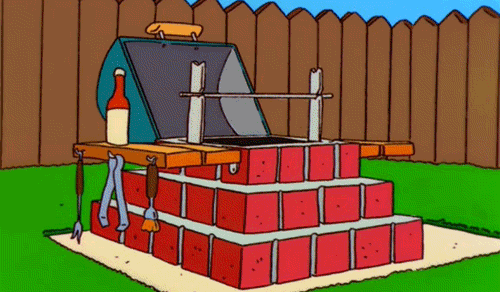
In my case, I don’t have 2 weeks. My sprint is only 2 days: every weekend. So I make sure each task I write in a card is achievable within 2 days. If I think a task can’t be finished in 2 days, I divide it into several subtasks.
For example, “obtaining items from chests” might be too complex, so I could divide that to these subtasks:
being able to define chests as a list of the items inside it, and being able to save that data to file
being able to place chests in the map, each chest being: a 3d model of the chest, and the data file saying what items are inside it
create the GUI art for viewing items inside a chest
put the GUI art in-game and adding code to allow it to react to user-input
implement the code for transferring items from a chest to the player’s inventory and vice-versa
Fifth is to concentrate on having a working, playable work-in-progress.
The thing to aim for here is that at the end of each sprint, whatever progress you make should be something that works in-game. It’s fine if you don’t get that all the time, but I think aiming for it helps pull everything towards that direction.
I think this video of Bayonetta’s prototype says a lot:
youtube
For reference, here’s how the final product looks like:
youtube
You can see from that prototype video that you can already start working on the gameplay even if you don’t have the art finalized yet (because the art can take a long time to get done).
I think that’s the wiser method of doing things, you get a playable work-in-progress without being stalled by the fact that the art is incomplete. It’s even better because it’s easier to adjust animations while they’re still rough: it’s less motions to re-arrange and tweak whenever you need to adjust it.
It’s also not good to base your judgement of how correct an animation is from just looking at it in Blender/Maya/etc. alone, because you aren’t seeing it being used in-game. For all you know, the sword attack you’ve been polishing for so many days doesn’t really work because the arc of the sword swing doesn’t really reach the intended target! Or maybe you didn’t realize that the swing is making the sword pass through the ground mesh unintentionally!
Or maybe there’s certain situations where your animation really just needs to be tweaked (when fighting inside narrow hallways, or when you are standing on a flight of stairs & attacking a target below you, etc.). It’s really better to test it out in-game as soon as you’ve established the key frames of your animation.
Frankly, this is something that I should learn to do myself!
And what about for the story? I think this is a neat trick in designing a prototype for your game’s story:
youtube
(the video’s about half an hour long, but it’s worth it)
The basic gist is that you design a “board game” out of your game’s story. And I think that’s the proper way to do things. There’s really more to it than what I just said, so I encourage you all to watch that video.
Sixth is to handle feedback as objectively as you can. As a solo developer, you will tend to see your game as your “baby”, something that in your eyes is a flawless creation.
Maybe you expect players to always do something, but turns out it never crosses their minds at all. That might be a symptom that you need to fix your game’s design.
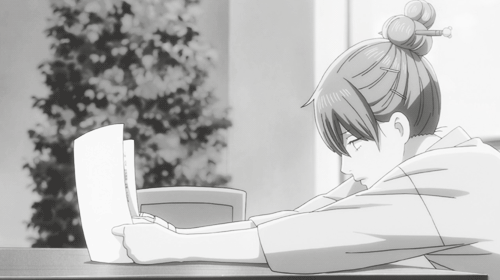
Be clear with what you are asking feedback for. Just posting screenshots, and a vague “this is my game, suggestions and feedback are welcome!” will not help, because people will tend to give you suggestions that are not in line with the goal you have set in mind for the game, and you end up sounding defensive trying to explain things.
Explain your intent with what you’re specifically showing, and ask for feedback if people think your work achieved that intent or not. But start with a 2 to 3 sentence blurb that describes the premise of your game, to set the tone. Here’s a good tutorial for that.
Take the time to appreciate when people praise you, but don’t let it get to your head.You shouldn’t keep yourself in a circle full of yes-men, you will just not improve there. On the other hand, don’t think that just because you’re being the target of verbal abuse that you are finally getting the so-called brutally honest feedback.
You really have to ignore the emotional parts of what people post, good or bad. Read between the lines of what’s being said, to find the truly useful feedback you want for improvement (if there is even any in their posts).
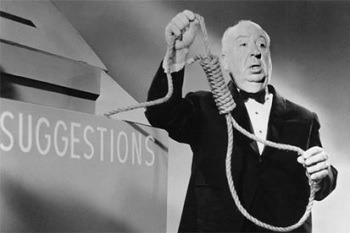
But don’t just follow every suggestion that comes along your way. Sift through it and think about why someone said what they said.
In my first playable demo, many were complaining that the player should be allowed to move more responsively, to be able to cancel attacks into movement. But that went against my intention of giving it a Dark Souls type of combat (instead of a Dynasty Warriors style of combat).
I realized, people were having that problem because I placed far too many enemies in the level. No one suggested that I lessen the amount of enemies, but that was really my mistake with that one.
So there really was a problem, but their suggestion was not the best way to fix it.
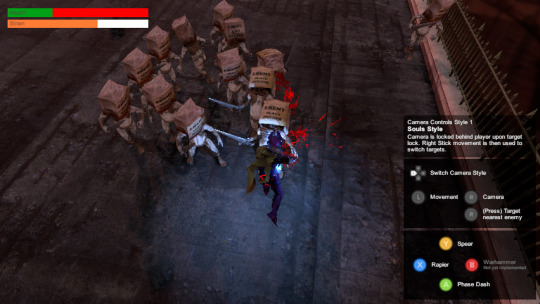
Another example: When Magicka was still being developed, some beta testers complained that friendly fire ruins the experience, and kept suggesting to remove it, or at least have the option to disable it. But the developers doubled down on their decision to have friendly-fire, because friends hitting each other was part of the humor that they wanted to achieve, so they decided to leave it there, and they were right.
I’ll end all of this by saying, this is only my way of doing things. It’s perfectly reasonable if you discover a different way that works for you!
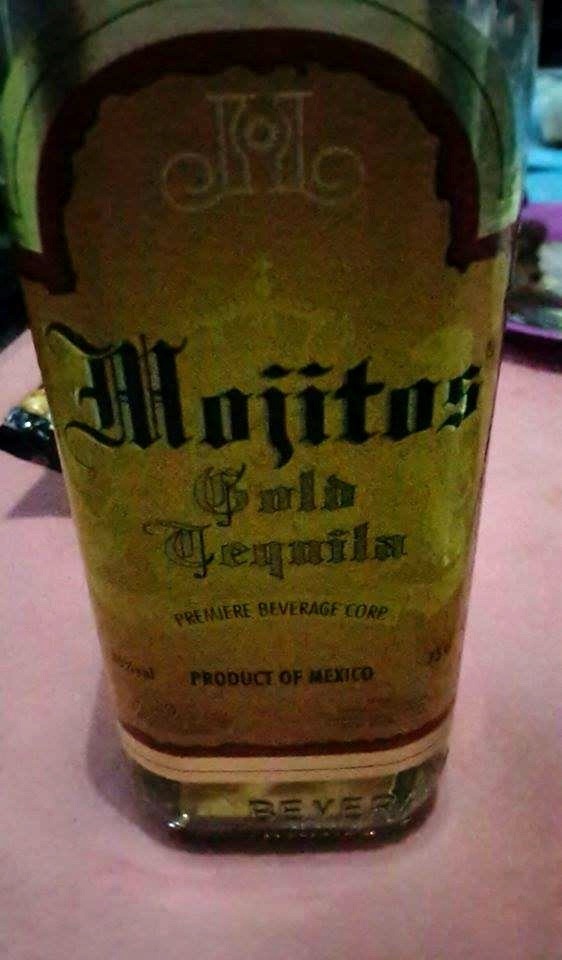
I always keep a bottle of Tequila handy under my desk.
115 notes
·
View notes
Text
TROUBLE BOYS notes and review
I had been meaning to read this for a long time before I started, and when I did it was hard to get through. It took almost a year to read and I feel like the world around me changed and affected my view of the book. We’re at a moment in history where we are finally saying “stop excusing abusive behaviors for art.” The Replacements were unhealthy and at times abusive. (The way they insisted that people around them keep up with them drinking was definitely abusive.) Throughout the book there is testimonials of people who worked with a lot of other rock musicians who were still shocked by The ‘Mats. They made everyone else look disciplined. So it’s not a pleasant book to read. But it’s an experience, so I’m copy and pasting my Goodreads updates from while reading it, adding some thoughts in brackets. Then I’ll add some final thoughts.
September 13, 2017 – page 45
8.64% "I've been excited to read this for a while, but the thing is, I really had no idea how much tragedy would be at the start. This clarifies a lot I thought I knew, like why Bob thought starting a band would help his brother have a better life. The books detailing of the story makes how Paul joined the band a lot less creepy than my initial impression, though I'm surprised by how manipulative he comes off."
[For people considering reading this and need content warnings, Bob Stinson was sexually molested by his half siblings’s father/mother’s boyfriend. It was the start of his substance abuse and probably part of why , unlike every other member of the band he never got clean. Paul Westerberg’s early trauma involves being hit in the head with a baseball bat, an alcoholic father and a teen friend who died by suicide.]
February 20, 2018 – page 124
23.8% "I’m slow at getting to this, but it’s amazing and I have many questions."
[I don’t remember questions I had at this point.]
March 13, 2018 – page 152
29.17% "Decided to use a long bus trip to get back to this. Just passed the part that describes Chris Mars’s surprise alter ego, Pappy the Clown. That’s the sanest member of the band!
Also I don’t know what it was like to be there, but the book practically makes “this is the love story of Paul and Tommy” its refrain."
[After living the band Mars became a successful painter. Notably in the the interviews here he has a very unromantic view of how the band stayed together and the creative process. I have to respect his never go back decision.
Also every attempt to summarize Paul and Tommy’s relationship fails because it is way too thorny.]
March 13, 2018 – page 191
36.66% "One of the reasons I’ve been so slow to read this is so fucking tragic. Almost everything about Bob Stinson’s life feels so awful. At the art where his possible schizo-affected disorder becomes more pronounced and he’s sort of forced out of the band.
I feel like the book is almost interactive in some parts. Steve Albini shows up at one point and I start shouting “fuck Steve Albini!” In my head."
[There was mercifully little Steve Albini in this book. It did however give mini biographies of every producer with whom they ever considered working, which is part of why it’s so long.]
June 18, 2018 – page 271
52.02% "I keep putting this aside because reading about some of the active self sabotage and ass hole behavior is too much. It’s so different when reading about actual events than the general summary that they shot themselves in the foot.
I keep wishing they had fewer enablers and wondering if there would be any story if they did."
[I think this last paragraph sums up my feelings on the subject.]
July 6, 2018 – page 300
57.58% "This much self sabotage is painful to read about. Also I worry about what isn’t in this warts and all coverage."
[I mostly meant the band’s treatment of women. I got some of what I carried about in the part where everyone gets married around the same time. They all expected their wives to keep some sense of stability for them at home while the fooled around on the road. Westerberg’s first wife keeps talking about how ignorant she was of much of what he did back then. There isn’t much point of view from the groupies. Also there is a lot about how much Paul and Tommy saw Chris’s wife Sally as a destructive interloper. But all things considered, Sally comes across as one of the only sensible people to get involved with the band. She helped Chris stand up for himself when things with the other members were definitely emotionally abusive. It’s no wonder that this is the only marriage amongst the original members that didn’t end in divorce.
I was surprised to learn that many of their songs were Westerberg writing about his sisters’s experiences. I always thought “Waitress in the Sky” was kind of misogynistic, and now I know it’s from the point of view of the kinds of horrible passengers his sister, a flight attendant, met and told stories about. So it is misogynistic, but also, not? ]
July 26, 2018 – page 352
67.56% "I’m going to try and push my way through the end of this book this weekend. The never really having highs but lots of dangerous lows aspects of the story would be too much if it weren’t for bizarre anecdotes like the band’s connection to the movie HEATHERS."
[I did finish the book that weekend! Skipped most of the end notes which should explain how it was possible.
A little comment about the Heathers thing: Between seasons one and two of Stranger Things I really wanted The Replacements to be on the soundtrack for season 2. I even wrote that online in a couple of places. Now that I know Westerberg had some kind of non-sexual but much speculated about relationship with Winona Ryder I feel weird about that. Maybe the kids should be into Hüsker Dü? Or early R.E.M.? I should note that I was surprised by the rivalry with the latter band emphasized here, and how frequently Peter Buck showed up as an interview subject.]
The book took years to write and a lot happened in those years. This includes, a reorganizing and rerelease of the band’s back catalogue, the end of Westerberg and Tommy Stinson’s second marriages, Slim Dunlap had a debilitating stroke, a reunion and another break up. As my notes earlier suggest, I spent a lot of the book wondering how different things would be if they cleaned up earlier. If anything the results of recent years seem to say it’s too late to tell.
The author, Bob Mehr, tries to tie things together by saying that their early supporters were proven right by their post break up successes. But does that make it worth it? I really love some of the music. And I love a lot of music that was influenced by the band (it’s what led me to them). But I still can’t answer that question.
#The Replacements#paul westerberg#Bob Stinson#tommy stinson#chris mars#what I'm reading#trouble boys: the true story of the replacements#bob mehr#the 1980s#music#rock biography#slim dunlap
1 note
·
View note
Text
Project Proposal, In submission for Major Project 1
Working title: Everything is Liable to turn Red.
Overview: The project I am proposing is a single channel film that illustrates the experience of an oncoming danger that cannot be stopped, nor suppressed by either fiction or the images that we constitute as reality.
Inspired by Jacques Lacan's proposed theory that there are three registers of experience: the Imaginary, the Symbolic, and the Real, I intend to produce a work of art that not only visualises the proposed theory but also demonstrates, and affects the audience, with the experience that the theory elucidates.
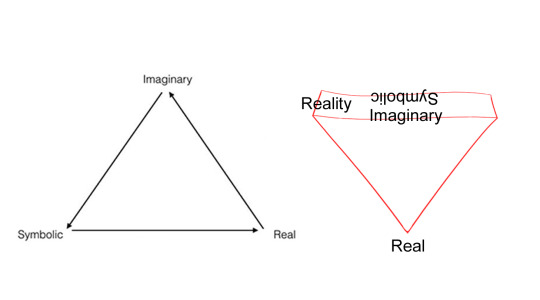
The image on the left is an illustration of the triadic structure of the mind. The conception that 'we' spontaneously structure our perception of concepts in a triadic composition is not singular to Jacques Lacan, having been used in many intellectual traditions by both post-war phenomenologists’ and also pre-feudal pagans in their rituals, but it is Lacan's triadic structure that I shall follow most closely. However, what should be recognised is that a two-dimensional representation of Lacan's theory of conscious motion would not be apt for a film. The image on the right is then a three-dimensional rendering of the triadic structure, and it is this formulation that I shall use to compose my piece. Simply put, the collaboration of the imaginary (that is of images) with the symbolic (an images differed meaning) constitutes the plain of reality. Using abstract symbols that have through artistic practice come to denote specific of this world meanings, I will elicit the construction of a reality by the audience that will masks a hidden danger (the Real), represented as a pulsating red.
Context: In my extended essay, I wrote of how cinema and its institution has become an ideological apparatus for maintaining the status quo. That the images that have come to constitute our reality presented on the screen, are those that have been assimilated to dissolve their substance. That is to say; the culture industry makes sure all conceptions of life pass through its mechanisms so that it may establish what reality is, and not us. And by our agreement, we allow the inequitable system's reconstitution, having been tricked by its new, diverse, appearance. Essentially, the culture industry now decides what it means to 'be'. Instead of imitating us, we imitate it, separating ourselves from human individuality, resigning us as subjects to the system and its homogenised world view. This, inevitably, has compelled us to assume the role of 'simple consumer' who’s inherent trait is pacification when it comes to cultural products. My film intends to reactivate the spectator's role in film viewership through the use of abstract images. By avoiding symbols that have come to denote specific meanings in cinema (e.g., Knife=stabbing=penetration), I elicit meaning from the spectators' subconscious, thus making them active in the constitution of reality once more. To further add credence to my political intention, and why constituting reality for ourselves is so important, I will put the reality the audience is constituting under siege, the same way capitalism puts our imaginations under siege so that it may maintain its power and significance.
Method: Inspired by surrealist, abstract, and abstract impressionist painters I will collect found-footage to be used as new symbols to denote aspects of the real world (lines to denote trees inspired by Agnes Martin). I will then arrange these images so that they imitate the structure of Lacan's triadic structure of the mind. Beneath these images will be the real, a pulsating Red that will not let up. Utilising techniques that are afforded to me through editing software will make it appear as though the spectator is descending into the real. This should hopefully evoke anticipation and anxiety; emotions which Lacan proposed the real was the enteral cause of.
0 notes
Link
Mixing past and present | Art & Culture Love Song. Atif Khan has combed three strands of Pakistani art to put forward a hybrid: a blend of Mughal miniature, truck art and computer generated imagery. Early nineties are associated with the rise of Karachi Pop and the popularity of neo-miniature (born in Lahore). Recently many artists prefer digital prints so that initial training and previous experiences in relatively conventional formats are abandoned in favour of computer based works. Atif Khan studied printmaking at National College of Arts (1993-97), and produced prints using various techniques, but like many printmakers soon started seeking other forms of expression. Hence, the use of new technology in place of traditional methods. For several years now, he has developed a vocabulary with distinct features – rather ingredients. The language is at its loudest in the exhibition, More Love Songs, at Tanzara Gallery Islamabad; his solo show (October 22- November 5, 2020) includes archival inkjet prints from 2014 to 2020. For an artist, there are many paths towards a past: revival, critique, adoration, rejection, playfulness, indifference, assimilation. Often the journey to pervious eras is in search of ‘now’ or ‘self’. This is a quest through many crossroads. In Atif Khan’s case, one recognises the artist’s fascination with motifs which belong to this part of the world: emblems of identity. However, this too is a paradox; because an image from heritage relates to us in terms of geography but is foreign in the sense of time. In that respect, painters working in Mughal ateliers were our ancestors. However, if by some secret miracle, they are resurrected today, we won’t be able to comprehend a single sentence they uttered. Not only due to the Persian they speak but also on account of their way of perceiving objects, situations and ideas that would be alien to us. The situation is with local truck artists is no different; those not far in history but remote in social structure. A painter of decorative vehicles converses in a syntax that is partially understood by others – higher in hierarchy – though not appreciated or respected. Several artists, and some trendy persons have lately discovered the potential of popular truck painting, especially after it was appropriated by ‘high art’ (Karachi Pop). It is being re-produced on lanterns, teapots, utensils, charpoys, and other such mundane items. (In a sense, its descent into these pieces connects it with low-income groups and is a logical destination of truck art, originally practiced by individuals from similar social strata). However, the charm of this art is that it picks extrinsic sounds, and turns them into familiar meanings by infusing new content in them. Various Pakistani artists have dealt with traditional miniature painting and popular transport art using a similar approach. In their work, elements from past or from a distant pictorial practice assume new guises, roles and context. Today a considerable number of artists (like Atif Khan) are enthusiastically recreating Mughal miniature paintings in digital prints, reminding one of Arthur Waley, the English Sinologist, who said that “he preferred to read Dickens in Chinese translation”. An individual choosing the diction of digital has multiple questions to tackle in the privacy of his/her heart. Especially, if the pictorial substance is derived from previous examples, and peripheral sources. Why, what, how – and how far and how long? Atif Khan may have considered these points as one sees different solutions to the basic issue: what to do with an already existing matter. In his prints, past emerges in the form of king’s figure, water waves, clouds, plants (and horses, elephant, maps and architectural details). Popular art comes in its multiple manifestations: burraq, birds and fish. Yet Khan is not content with this bag of visuals, so he adds references from European Art (angel-like flying creatures), and pictures from contemporary life (banners of three major political parties of Pakistan). What comes out of this diverse body of sources, is an apparently complex concoction that engages you, impresses you and delights you. On top of everything, it conveys something obvious. The nature and history of power: as a Mughal king, like a trapeze artist, is balancing while holding a pair of umbrellas on a rope suspended between two bridges (Naya Walah Pull IV). Political parties’ banners from this print, become prominent in another work (Naya Walah Pull III), in which one notices a range of motifs: a bridge squashed with its two sides visible simultaneously; fabrics bearing political messages; tiny figure of a Mughal ruler; a few barricades; and water, clouds and trees gathered from historic miniature paintings. In addition, side-walls of a bridge have Islamic geometric patterns. An ideal motif for an artist who desires to comment on present through past. One happily accepts and admires Atif Khan’s attempts to comment on socio-political nature of human society, till coming across a number of works in which past images are placed in uncanny settings: a king perched on a sailboat; a king and queen conversing while standing on different rocks; a historic building on the edge of a huge stone that is submerged in water and has a pattern of blue kufiyah (it is titled Love Song). It can be sensed that Atif Khan aims to communicate something profound, but profound does not take off common ground when it comes to a quick, easy and consumable route. The reading is reinforced by his other prints, in which pictorial segments are rotated, superimposed, and juggled around, revealing a decorative impulse. Especially in works like Mystic Flight, with a sequence of a burraq in flight against some unworldly water whirls encircled by transparent clouds. Or in Homage I and Homage II, in which fish and bird, representing colourful metal constructions made for/in transport art, expand from the centre of a circular surface. The Palace. A positive aspect of Atif Khan’s aesthetic is, that instead of current in-vogue monochromatic palette, he opts for a routine, rudimentary and ‘redundant’ multicolour approach with vibrant hues and vivid shades. Probably his inspiration, miniature and truck art, compels him. Treating this visual material – particularly in his latest prints, is his way of joining ages and areas: the Sixteenth Century melts into the Twenty-First, and the Muslim India meets Renaissance Europe, and high art merges with popular image-makers. What comes out of it is a certain content. However, the content is a problem as well. Because for many artists, including Atif Khan, content is merely a manipulation of certain images: computer options. He has rendered visually attractive pieces with strong colour compositions, and recognisable entities, but seeing some in oval shape, others in round, a few in square or rectangular – formats mostly lacking logical connection to content – projects the illusion of an enticing picture. The journey is in different dimensions with different combinations. The writer is an art critic based in Lahore https://timespakistan.com/mixing-past-and-present-art-culture-thenews-com-pk/5004/
0 notes
Text
Dieter Roth
Dieter Roth (1930–1998) was one of the most diverse artists in the second half of the last century. He was a painter, graphic designer, sculptor, publisher, musician, filmmaker, as well as a poet. Although he himself was interested in collecting and archiving, Roth’s complex and extremely varied oeuvre presents museums with a difficult task when it comes to the preservation of his works. Beyond the ironic and contradictory statements which he made, this is due to the nature of the works themselves: complex installation art; monumental objects and sculptures made from edible substances, such as chocolate, sugar, yoghurt, cheese, bread, mince and spices, which beetles and micro-organisms then transform. And while mutability and transience are inherent in all works of art, Roth accelerates these phenomena, making them visible within a short period of time. Mortality is, in effect, paraded in front of us. And so, when setting aside the ambiguity of the works for a moment, we can see that Dieter Roth was extremely interested in the structure of decay – its form, play of colours, the variations of putrefaction and mould, and their ornamental aspects, the natural mutation of things – and felt that chance, as a shaping element, should be a part of the creation process.
Do we have the right to dispute these artistic intentions because of our responsibility as museums to acquire, conserve, research, communicate and exhibit? Besides the usual preservation of the aesthetic and historical dimensions of a work, in Roth’s case, the museum has the contradictory need to conserve that which was intended to be ephemeral. And so we need to ask: is it legitimate to slow down the decay processes in a museum, in order to preserve the object for reasons of cultural heritage? What strategies can an institution pursue if the conservation of a work appears to contradict the intention of the artist who created it? Can a replica be a way of overcoming this paradox?
Taking into account the processual nature of these works, there is still the question of when is the endpoint of such ‘living works’ reached. At what point is an adequate interaction between the viewer and the work no longer possible, making its exhibition no longer meaningful? What changes does processual decay entail: colour changes and discoloration, distortion, loss of elements or collapse? Can these works reach a state of aging in their material continuity that poses a threat to their integrity or which contradicts their importance in terms of art history? It is less the result and more the continuing genesis of the work – its change and deformation through to decay – that is of importance. Is the endpoint therefore only reached at the point of material disintegration? Or is it reached through intervention in an immutable process and by acting contrary to the original artistic intention? Dieter Roth himself described the state of hardly perceptible degradation that works of art often reach after initial rapid degradation as a ‘museum life’.

Fig 2 – 1972
This threshold of slow aging has been passed by the sculpture of the Gartenzwerg2 created in 1972 and now in the Kunstmuseum Stuttgart. Because large cracks are forming in the chocolate casing which encloses the gnome, it is in danger of falling apart in the near future. Should we consider having a replica made to allow the visitor to visualise the original sculptural form? Admittedly, that is one of the ideas which comes to mind in this case. But are such approaches also to be adopted for his complex installation art which comprise numerous parts; the object images that have been assembled with great care; or the accumulation collages3 of diverse foods that give little clue any more as to the original contents? For example, what form should a replica of the latter works take? New layers of edible products such as bread, cheese and sausage mounted on a wooden sheet with milk and yoghurt poured over them? This option would limit the work to processuality and neglect any attempt to retain its authenticity, which may also include a large number of levels of meaning such as the aesthetic, historical, artistic, social and scientific dimensions.4 Umberto Eco spoke of the inequality of project and result: ‘A work of art is both a trace of that which it wanted to be and of what it actually is, if the two values do not coincide.’5 If a work is viewed as an object possessing certain structural characteristics and very diverse meanings, then an aspect like the degree of decay could lead the viewer to draw a parallel between the life of the work and his/her own life up to that point – something no longer possible with a replica.
In respect to the dialectic inherent in Roth’s work, we have to ask what factors would induce us to create replicas of his works.
1. The replica as a copy for exhibition purposes.6 For example, in order to make fragile works which are sensitive to shock and vibration more accessible in an era of numerous changing exhibitions.
2. The replica as a replacement. In the case of lost or damaged elements within an installation or an object image, this practice could be considered an equivalent to inpainting, which is intended to facilitate the reading and experience of a work.
3. The replica as a duplicate, documentation, and didactic aid to understanding. It could be shown side by side with the original, which is now unrecognisable as a result of aging, in order to help the viewer engage with the work, as well as presenting the different stages in processual decay?
4. The replica as a starting point for a new aging process. As mentioned earlier, this would, however, reduce the work to its processual character.
Setting aside the questions of authorisation and value, and the problem of control over the replica in Roth’s oeuvre, in which there are numerous editions, we also have to ask whether it is our intention to preserve for future generations the material form of works which have decay as their theme. Or would the importance of the artistic statement not be more powerfully put across if it was available solely in written and photographic documentation, as evidence of protest against the supposed eternal nature of art. ‘Fotogeschichten können anstelle der Restaurierungen treten,’8 [Photography can take the place of restoration as historical record] Roth once said. If, however, we want to prevent the decomposition of works, we must first ignore Dieter Roth’s questioning of the eternal nature of art and either use the methods of conservation to fix an object in a particular state or create replicas of works with a short lifespan. These replicas would repeat the process of decay for eternity.

Schokoladenmeer, 1970
Schokoladenmeer is one of a long series of works in which Dieter Roth used edible and organic materials such as sugar, bread, spices, sausages, cheese, sour milk, mould, excrement and chocolate. For this particular work, Roth shredded the manuscript of an unpublished novel and used the strips of paper and squares of chocolate to make a composition. The result is a sculpture consisting of squares of chocolate piled on top of each other to form numerous columns on a flat base, mixed with the strips of typed paper. In Schokoladenmeer, Roth pushes his ideas about the non-existence of the eternal artwork and about the immutability of art to their logical conclusions. The squares of Lindt chocolate remind us that artistic creation only makes sense if it is connected to life, and that even though all artworks are mutable and transitory by nature, this fact becomes even more obvious when organic materials are used.

Big Sunset (1968), pressing of sausage on cardstock in plastic cover

Literature Sausage (Literaturwurst) (1969), artist’s book of ground copy of Halbzeit by Martin Walser, gelatin, lard, and spices in natural casing
0 notes